小学英语等级考试一级-介词-数词(汇编)
- 格式:doc
- 大小:60.00 KB
- 文档页数:10
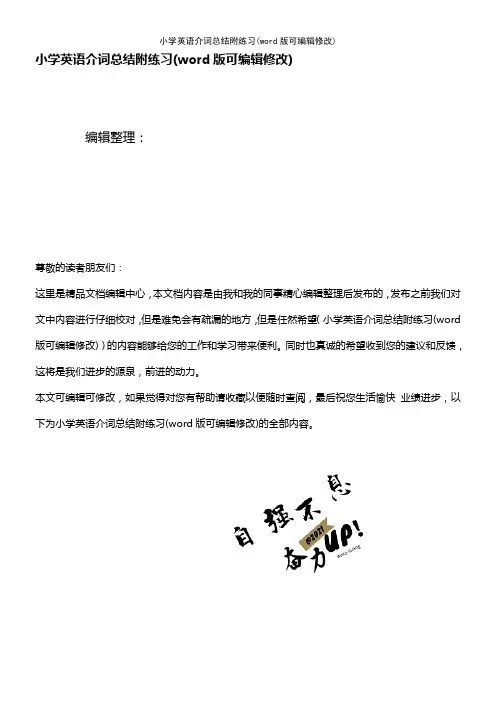
小学英语介词总结附练习(word版可编辑修改)编辑整理:尊敬的读者朋友们:这里是精品文档编辑中心,本文档内容是由我和我的同事精心编辑整理后发布的,发布之前我们对文中内容进行仔细校对,但是难免会有疏漏的地方,但是任然希望(小学英语介词总结附练习(word 版可编辑修改))的内容能够给您的工作和学习带来便利。
同时也真诚的希望收到您的建议和反馈,这将是我们进步的源泉,前进的动力。
本文可编辑可修改,如果觉得对您有帮助请收藏以便随时查阅,最后祝您生活愉快业绩进步,以下为小学英语介词总结附练习(word版可编辑修改)的全部内容。
小学英语介词总结介词(Preposition)一、概述介词是英语中很活跃的词,一般置于名词之前。
它常和名词或名词性词语构成介词短语。
同一个介词常和不同的词语搭配形成固定搭配,表示不同意义。
二、常用介词的基本用法at①表示时间: I go to school at seven every day 我每天早上7点去上学。
②表示在某一具体地点: He is standing at the bus stop 他站在公共汽车站。
③表示动作的方向、目标: Let me have a look at the picture 让我看看这幅图。
④用于某些固定搭配: at once 立刻、马上 at last 最后at the same time 同时 at first 开始时not at all 一点也不about①表示大约时间: I's about six o'clock now. 现在大约6点钟了。
②表示地点;在……周围: Everthing about me is so beautiful 我周围的一切都那么美好。
③关于,对于: We are talking about the news。
我们正在谈论新闻。
after①在……之后: After dinner I watch TV. 晚饭后我看电视.②在……后面: He came into the room after me. 他在我后面进了房间。
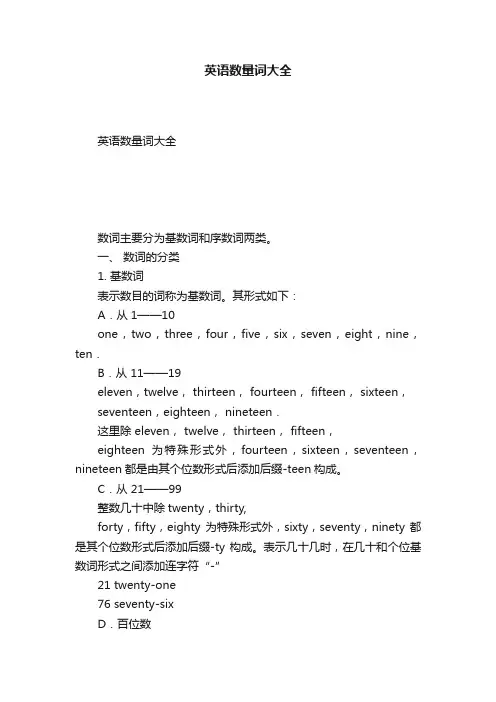
英语数量词大全英语数量词大全数词主要分为基数词和序数词两类。
一、数词的分类1. 基数词表示数目的词称为基数词。
其形式如下:A.从1——10one,two,three,four,five,six,seven,eight,nine,ten.B.从 11——19eleven,twelve, thirteen, fourteen, fifteen, sixteen,seventeen,eighteen, nineteen.这里除 eleven, twelve, thirteen, fifteen,eighteen为特殊形式外,fourteen,sixteen,seventeen,nineteen都是由其个位数形式后添加后缀-teen构成。
C.从 21——99整数几十中除twenty,thirty,forty,fifty,eighty为特殊形式外,sixty,seventy,ninety都是其个位数形式后添加后缀-ty构成。
表示几十几时,在几十和个位基数词形式之间添加连字符“-”21 twenty-one76 seventy-sixD.百位数个数基数词形式加“hundred”,表示几百,在几十几与百位间加上and.101 a hundred and one320 three hundred and twenty648 six hundred and forty-eightE.千位数以上从数字的右端向左端数起,每三位数加一个逗号“,”。
从右开始,第一个“,”前的数字后添加thousand,第二个“,”前面的数字后添加million,第三个“,”前的数字后添加billion。
然后一节一节分别表示,两个逗号之间最大的数为百位数形式。
2,648 two thousand six hundred and forty-eight16,250,064 sixteen million two hundred and fiftythousand sixty-four5,237,166,234 five billion,two hundred and thirty-sevenmillion,one hundred and sixty-six thousand,two hundred and thirty-fourF.基数词在表示确切的数字时,不能使用百、千、百万、十亿的复数形式;但是,当基数词表示不确切数字,如成百、成千上万,三三两两时,基数词则以复数形式出现。
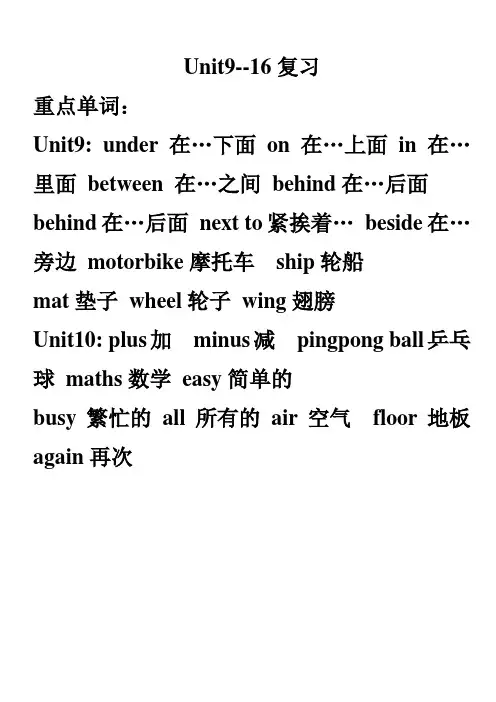
Unit9--16复习重点单词:Unit9: under在…下面on 在…上面in在…里面between 在…之间behind在…后面behind在…后面next to紧挨着…beside在…旁边motorbike摩托车ship轮船mat垫子wheel轮子wing翅膀Unit10: plus加minus减pingpong ball乒乓球maths数学easy简单的busy繁忙的all所有的air空气floor地板again再次Unit11: grandma/grandmother 奶奶,外婆grandpa/ grandfather爷爷,姥爷brother哥哥弟弟sister姐姐妹妹father爸爸mother妈妈nephew侄子cousin表兄弟niece 侄女family tree家谱water水/浇水water the flowers浇花paper纸newspaper报纸seat座位second秒minute分钟hour小时day天week周month月year年Unit12: hobby爱好often经常together一起cool酷的helpful有帮助的about关于Unit13: shirt衬衫dress连衣裙jacket夹克衫hat帽子T-shirt T恤衫socks袜子glasseS 眼镜trousers裤子shorts短裤different不同的these这些thing东西often经常group组paper纸clothes衣服Unit14: bookcase书架feed喂tidy整理story故事mop拖scrub用力擦sweep扫cupboard碗橱,食橱comb梳fast快速的cross穿过,通过kind有好的,友善的schoolbag书包hand 传递buy买remember记起often经常heart心脏friendly友好的lend借给Unit15: everybody每人,人人word单词guess猜测shot射击fish钓鱼blow吹riddle谜语Unit16: quitely安静地fast快速的asleep睡着的past超过leaf树叶(复数--leaves)suddenly突然地break打破,打碎turnip萝卜fire火coop鸡笼重点词组:Unit9: get off下车get on上车at school在学校in the tree在树上Unit10: take away拿走,带走in the air在空中on the floor在地板上Unit11: read a newspaper读报纸take a seat 坐下=sit down in a minute一会儿Unit12: go shopping去购物talk with friends 和朋友说话fly a kite放风筝roller-skating 滑旱冰listen to music听音乐climb trees爬树lots of许多=a lot ofUnit14: tidy the books整理书read a story book读故事书feed the bird喂鸟feed the dog喂狗mop the floor拖地scrub the floor用力刷地板sweep the floor扫地clean the window擦窗户comb hair梳头发clean the kitchen清洗厨房wash the tomatoes洗西红柿clean the cupboard清洗食橱lend a hand帮忙,助一臂之力at home在家in class在课堂上make things 制作东西every day每天do homework做作业listen to 听make tea 沏茶Unit15: make words制作单词guess game猜一猜游戏guess riddle猜谜语blow balloon吹气球guess a good shot做一个好射击Unit16:重点句子:1、Unit9:Where is my toy car ? 我的玩具小汽车在哪里?2、Where is it? 它在哪里?--- It's under the cap. 它在帽子下面。
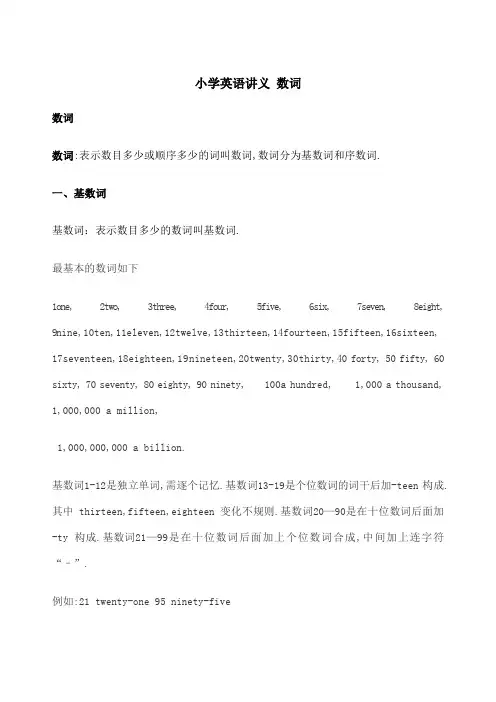
小学英语讲义数词数词数词:表示数目多少或顺序多少的词叫数词,数词分为基数词和序数词.一、基数词基数词:表示数目多少的数词叫基数词.最基本的数词如下1one, 2two, 3three, 4four, 5five, 6six, 7seven, 8eight,9nine,10ten,11eleven,12twelve,13thirteen,14fourteen,15fifteen,16sixteen,17seventeen,18eighteen,19nineteen,20twenty,30thirty,40 forty, 50 fifty, 60 sixty, 70 seventy, 80 eighty, 90 ninety, 100a hundred, 1,000 a thousand, 1,000,000 a million,1,000,000,000 a billion.基数词1-12是独立单词,需逐个记忆.基数词13-19是个位数词的词干后加-teen构成.其中thirteen,fifteen,eighteen变化不规则.基数词20—90是在十位数词后面加-ty构成.基数词21—99是在十位数词后面加上个位数词合成,中间加上连字符“–”.例如:21 twenty-one 95 ninety-five基数词三位以上的数词在百位和十位之间,一般要用连词“and”.例如:132 one hundred and thirty-two.1340 one thousand three hundred and forty表示“万”的词英语中没有.如1万可用10千来表示:ten thousand. 30万可用three hundred thousand来表示.基数词的用法:基数词在句中可用作主语,宾语,表语等.Four of them went to the factory.他们四个人去了工厂.主语I want two.我要两个.宾语There are thirty classrooms in our school.我们学校有三十个教室.My classmate is eighteen.我的同学十八岁.从事物内容上分析,基数词用在下列情况.1基数词可以表示物体的数量.如:three boo k s 三本书 five b o x e s五个盒子t w o cups o f t e a两杯茶 ten pieces o f b r ea d十片面包2基数词可以表示钟点.如:8:00读为eight o’clock 6:10读为six ten5:01读为one past five10分钟以内的时间,可以这样说“钟点数+o英文字母o的发音+分钟”.例如:6:05—six o five3基数词可表示年龄.如:How old is Tom He is tenyears old.How old are they They are nineyears old.How old is your sister She is elevenyears old.4基数词还可表示在几年级几班.英语中表达在几年级几班时通常班级在前,年级在后,班级和年级间要用逗号隔开.例如:I’m in Class 2, Grade 4.我在四年级二班.注意:Class和Grade后的数字既可以用阿拉伯数字,也可以用英语中的基数词表示,但基数词和名词的首字母要大写.例如:Class 4 = Class FourGrade 3 = Grade Three5基数词还可用于算式中.如:one + nine = tentwelve - seven = fivethree ×three = nineeight ÷two = four6基数词用于分数.构成:基数词代表分子,序数词代表分母.分子大于1时,分子的序数词用单数,分母序数词用复数:1/3 one-third ; 3/37 three thirty-sevenths.例题分析1. one, three, ______ , sevenA. twoB. fiveC. six答案:B思路分析:每个数字间相差2.2. I’m in _____.A. Grade 3, Class 2B. Class 3, grade 2C. Class Three, Grade Two答案:C思路分析:Cla ss和Grade后的数字既可以用阿拉伯数字,也可以用英语中的基数词,但基数词和各词的首字母应大写.3. It’s five ______.A. o’clockB. clockC. o clock答案:A思路分析:基数词可以表示钟点.整点后要加o’clock.4. The English for 10,440 is_________.A. ten thousand, four hundreds and fortyB. ten thousand, four hundred and fortyC. ten thousands, four hundred and fortyD. ten thousand and four hundred, forty本题在于掌握千以上数字的读法,在千、百前面有数字,不加复数;百位、十位中间加and ,每三位为一组,再加相应的单位即可,故选B5. --- Can you write the number eighty-five thousand, six hundred and twenty-six--- Yes, it is_________.A. 85662B. 85626C. 85006D. 85000千以上的数字,从后往前三个数为一个单位,即从85之后顺次写出三个数即可,即626,连在一起即为85626.故选B.6. The road is over _________ meters long.A. six hundred and fifty-twoB. six hundreds and fifty twoC. six hundred, fifty –twoD. six hundred, fifty and two百、千、百万等词与数字连用不用复数,因此不加s.其次表示百位数时要在百位和十位之间无十位,则在百位和个位之间加and ,再次在个位与十位之间要有连字符“-”,故本题选A相应练习1、--How many teachers are there in your school-- _________, but I’m not sure.A. HundredsB. HundredC. Hundreds ofD. One hundred2、What time is itof3. About _________ of the books in our school library are written in Chinese.A. fouth-fifthsB. four–fifthC. four–fifthsD. fourths-fifth二、序数词序数词:表示数目顺序的词用序数词.例如: first第一,fifth第五序数词的构成1—99的基本的序数词.first第一second第二third第三fourth第四fifth第五sixth第六seventh第七eighth第八ninth第九tenth第十eleventh第十一twelft第十二thirteenth 第十三nineteenth第十九twentieth第二十fortieth第四十fifty-first第五十一eight-third第八十三ninety-fourth第九十四.2十位整数的序数词的构成方法是,是将十位整数基数词的词尾y变成i再加-eth. 3几十几的序数词,只是把个位数变成序数词,十位数不变.为了更简单地记忆,你只要记住下面这个基数词变序数词口诀就可以了:,ve变f,y变成tie,th最后加上去.序数词的用法1序数词主要用作定语,表语.前面要加定冠词the.The first question I'd ask is how you knew him我的第一个问题是你怎样认识他的The fifth lesson is very easy to learn.第五课很好学.You are the first one I believe.你是我最相信的人.The fist round of voting hasn't finished.第一轮投票还没有结2)某月的几号用序数词表示如7月1日=July I July Ist1996年6月3日=June 3, 1996=June the third, nineteen ninety-six相应练习一、写出下列基数词的序数词.1_________ 5_________ 9_________51_________ 20_________二、选择.1. I think that the _________ century 世纪 will bring us more hopes.A. twenty-oneB. twentieth-firstC. twenty-firstD. twentieth-one2. There are _________ days in a week.A. the sevenB. seventhC. the seventhD. seven基数词变序数词的口诀英语中基数词变为序数词时,一般在基数词后加词尾-th,但有几个词变化特殊,只要记住下面这个口诀,这些问题即可迎刃而解.一、二、三,单独记;八去t,九除e,五、十二中f变ve,再加词尾-th;整十基数变序数,先把y尾改ie;要是遇到两位数,十位基数个位序.解析口诀:one→first, two→second, three→third这三个词变化特殊,要单独记;eight→eighth, nine→ninth, 八去t,九去e后再加-th;five→fifth, twelve→twelfth,五、十二把ve换成f再加-th;twenty→twentieth,thirty→thirtieth... 整十先把词尾y改为ie再加-th.两位数时则十位数用基数词,个位数用序数词,如:twenty-first.课后练习一、写出下列基数词和序数词.1________ ________ 2________ _______ 3________ ________ 5_______ _______20________ ________ 71________ ________二、选择题.三、 1. My grandmother is_____ old.四、 A. seventieth B. seventy year五、 C. seventy years D. seventies六、 visit this museum every day.七、 A. Hundred B. Hundreds八、 C. hundred of D. Hundreds of九、 3. There are two ________people in the meeting room.十、 A. hundred B. hundreds十一、 C. hundreds of D. hundred of十二、 4. We can say the number 78,645 in English like this________.十三、 A. seventy-eight thousand and six hundred and forty-five十四、 B. seventy-eight thousand six hundred and forty five十五、 C. seventy-eight thousand six hundred and forty-five十六、 D. seventy eight thousand six hundred and forty-five十七、 5. Monday is the second day, and________.十八、 A. Tuesday is the fourth B. Thursday is fifth十九、 C. the second day is Tuesday D. the second day is Thursday 7. There are ________months in a year. December is the ________month of the year.A. twelve; twelveB. twelve; twelfthC. twelfth; twelveD. twelve; twelveth9. What is five and eightA. TwelveB. ThirteenC. FourteenD. Fifteen。
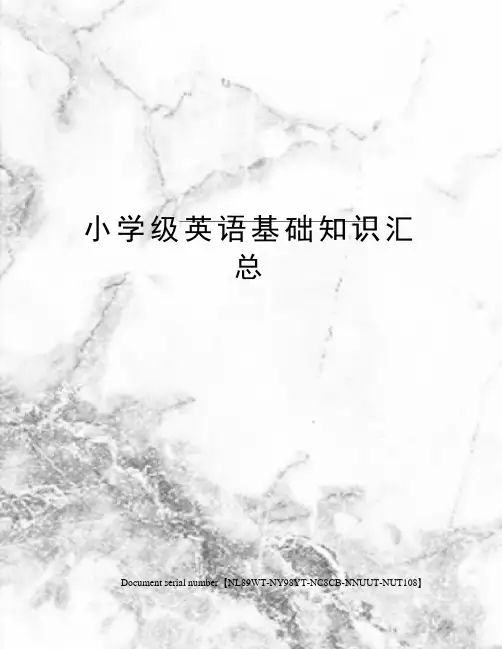
小学级英语基础知识汇总Document serial number【NL89WT-NY98YT-NC8CB-NNUUT-NUT108】小学1-6年级英语基础知识汇总{ 第一部分}基础知识1.字母:26个字母的大小写A B C D E F G H I J K L M N O P Q R S T U V W X Y Za b c d e f g h i j k l m n o p q r s t u v w x y z2.音标:48个音标3.词汇:词汇量,近反义词4.句子:大小写,标点符号{ 第二部分 }语法知识一.名词:名词单复数,名词的格(一)名词单复数1.一般情况,直接加-s,如:b o o k-b o o k s,b a g-b a g s,c a t-c a t s,b e d-b e d s2.以s.x.s h.c h结尾,加-e s,如:b u s-b u s e s,b o x-b o x e s,b r u s h-b r u s h e s,w a tc h-w a t c h e s3.以“辅音字母+y”结尾,变y为i,再加-e s,如:f a m i l y-f a m i l i e s,s t r a w b e r r y-s t r a w b e r r i e s4.以“f或f e”结尾,变f或f e为v,再加-e s,如:k n i f e-k n i v e s5.不规则名词复数:m a n-m e n,w o m a n-w o m e n,p o l i c e m a n-p o l i c e m e n,p o l i c e w o m a n-p o l i c e w o m e n,m o u s e-m i c ec h i l d-c h i ld re n,f o o t-f e e t,t o o t h-t e e t h,f i s h-f i s h,p e o p l e-p e o p l e, C h i n e s e-C h i n e s e,J a p a n e s e-J a p a n e s e不可数名词的复数就是原型:p a p e r,j u i c e,w a t e r,m i l k,r i c e,t e a(二)名词的格(1)有生命的东西的名词所有格:a)单数后加’s如:L u c y’s r u l e r m y f a t h e r’s s h i r tb)以s结尾的复数名词后加’如:h i s f r i e n d s’b a g sc)不以s结尾的复数后加’s c h i l d r e n’s s h o e sl并列名词中,如果把’s加在最后一个名词后,表示共有,如:T o m a n d M i k e’s c a r汤姆和迈克共有的小汽车l要表示所有物不是共有的,应分别在并列名词后加’sT o m’s a n d M i k e’s c a r s汤姆和麦克各自的小汽车(2)表示无生命东西的名词通常用“o f+名词”来表示所有关系:如:a p i c t u r e o f t h e c l a s s r o o m a m a p o f C h i n a二.冠词:不定冠词,定冠词种类:(1)不定冠词:a/a n元音开头的可数名词前用a n:a n e g g/a n a p p l e/a n o r a n g e/a n e r a s e r/a n a n s w e r/a n I Dc a r d/a n a l a r m c l o c k/a n a c t o r/a n a c t r e s s/a n e-m a i l/a na d d r e s s/a n e v e n t/a n e x a m p l e/a n o p e r a/a n h o u r a n o l d m a n/a n i n t e r e s t i n gb o o k/a n e xc i t i n g s p o r t/a n a c t i o n m o v i e/a n a r tl e s s o n/(2)定冠词:t h e定冠词的用法:(1)特指某(些)人或某(些)物:T h e r u l e r i s o n t h e d e s k.(2)复述上文提到的人或物:H e h a s a s w e a t e r.T h e s w e a t e r i s n e w.(3)谈话双方都知道的人或物:T h e b o y s a r e n’t a t s c h o o l.(4)在序数词前:J o h n’s b i r t h d a y i s F e b r u a r y t h e s e c o n d.(5)用于固定词组中:i n t h e m o r n i n g/a f t e r n o o n/e v e n i n g不用冠词的情况:(1)专有名词前:C h i n a i s a b i g c o u n t r y.(2)名词前有定语:t h i s,t h a t,m y,y o u r,s o m e,a n y,n o等:T h i s i s m y b a s e b a l l.(3)复数名词表示一类人和事:M o n k e y s c a n’t s w i m.T h e y a r e t e a c h e r s.(4)在节日,日期,月份,季节前:T o d a y i s C h r i s t m a s D a y.I t’s S u n d a y.(5)一日三餐前:W e h a v e b r e a k f a s t a t6:30.(6)球类棋类运动前:T h e y o f t e n p l a y f o o t b a l l a f t e r c l a s s.H e p l a y sc h e s s a t h o m e.*但乐器前要用定冠词:I p l a y t h e g u i t a r v e r y w e l l.(7)学科名称前:M y f a v o r i t e s u b j e c t i s m u s i c.(8)在称呼或头衔的名词前:T h i s i s M r L i.(9)固定词组中:a t n o o n a t n i g h t b y b u s三、代词、形容词、副词代词:人称代词,物主代词人称代词物主代词主格宾格第一人称单数I(我)m e m y(我的)复数w e(我们)u s o u r(我们的)第二人称单数y o u(你)y o u y o u r(你的)复数y o u(你们)y o u y o u r(你们的)第三人称单数h e(他)h i m h i s(他的)s h e(她)h e r h e r(她的)i t(它)i t i t s(它的)复数t h e y(他们/她们/它们)t h e m t h e i r(他们的/她们的/它们的)形容词,副词:比较级,最高级(一)、形容词的比较级1、形容词比较级在句子中的运用:两个事物或人的比较用比较级,比较级后面一般带有单词t h a n。
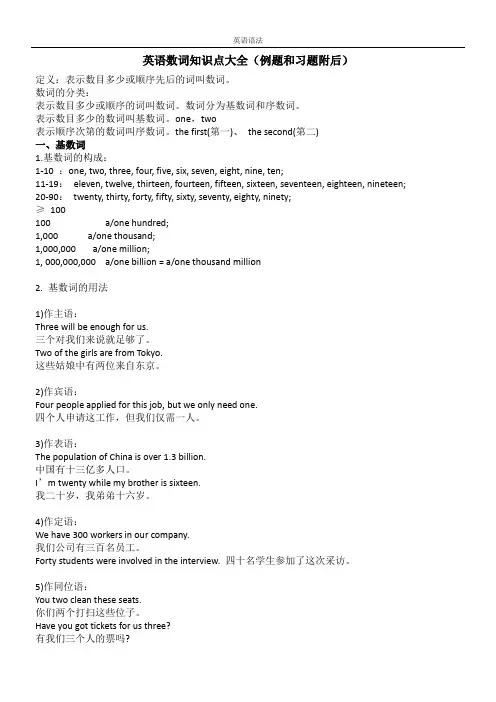
英语数词知识点大全(例题和习题附后)定义:表示数目多少或顺序先后的词叫数词。
数词的分类:表示数目多少或顺序的词叫数词。
数词分为基数词和序数词。
表示数目多少的数词叫基数词。
one,two表示顺序次第的数词叫序数词。
the first(第一)、the second(第二)一、基数词1.基数词的构成:1-10 :one, two, three, four, five, six, seven, eight, nine, ten;11-19:eleven, twelve, thirteen, fourteen, fifteen, sixteen, seventeen, eighteen, nineteen; 20-90:twenty, thirty, forty, fifty, sixty, seventy, eighty, ninety;≥100100 a/one hundred;1,000 a/one thousand;1,000,000 a/one million;1, 000,000,000 a/one billion = a/one thousand million2. 基数词的用法1)作主语:Three will be enough for us.三个对我们来说就足够了。
Two of the girls are from Tokyo.这些姑娘中有两位来自东京。
2)作宾语:Four people applied for this job, but we only need one.四个人申请这工作,但我们仅需一人。
3)作表语:The population of China is over 1.3 billion.中国有十三亿多人口。
I’m twenty while my brother is sixteen.我二十岁,我弟弟十六岁。
4)作定语:We have 300 workers in our company.我们公司有三百名员工。
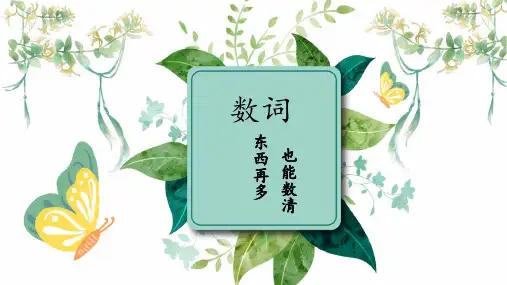
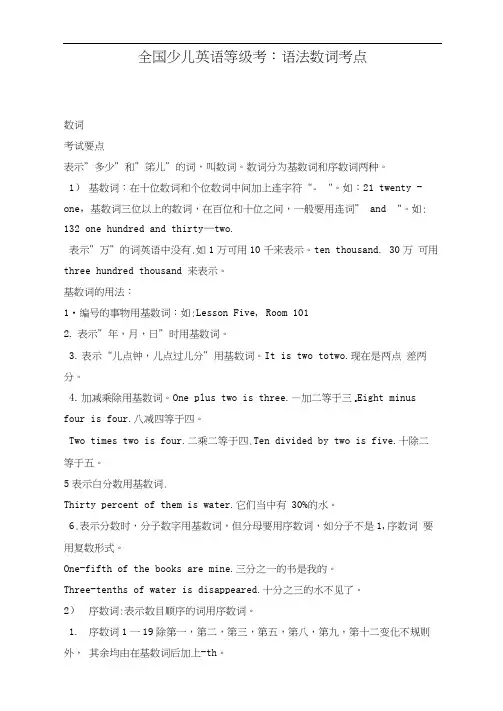
全国少儿英语等级考:语法数词考点数词考试要点表示”多少”和”笫儿”的词,叫数词。
数词分为基数词和序数词两种。
1)基数词:在十位数词和个位数词中间加上连字符“- “。
如:21 twenty -one,基数词三位以上的数词,在百位和十位之间,一般要用连词” and “。
如: 132 one hundred and thirty—two.表示”万”的词英语中没有.如1万可用10千来表示。
ten thousand. 30万可用three hundred thousand 来表示。
基数词的用法:1•编号的事物用基数词:如:Lesson Five, Room 1012.表示”年,月,日”时用基数词。
3.表示“儿点钟,儿点过儿分”用基数词。
It is two totwo.现在是两点差两分。
4.加减乘除用基数词。
One plus two is three.—加二等于三c Eight minus four is four.八减四等于四。
Two times two is four.二乘二等于四.Ten divided by two is five.十除二等于五。
5表示白分数用基数词.Thirty percent of them is water.它们当中有30%的水。
6.表示分数时,分子数字用基数词,但分母要用序数词,如分子不是1,序数词要用复数形式。
One-fifth of the books are mine.三分之一的书是我的。
Three-tenths of water is disappeared.十分之三的水不见了。
2)序数词:表示数目顺序的词用序数词。
1.序数词1一19除第一,第二,第三,第五,第八,第九,第十二变化不规则外,其余均由在基数词后加上-th。
2.十位整数的序数词的构成方法是,是将十位整数基数词的词尾-y变成i 再加-etho3.儿十儿的序数词,只是把个位数变成序数词,十位数不变。
4.第一白以上的多位序数词由基数词的形式变结尾部分为序数词形式来表示。
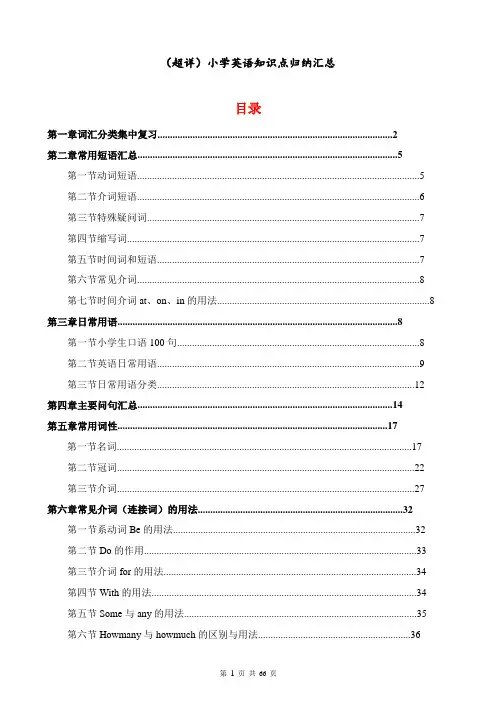
(超详)小学英语知识点归纳汇总目录第一章词汇分类集中复习 (2)第二章常用短语汇总 (5)第一节动词短语 (5)第二节介词短语 (6)第三节特殊疑问词 (7)第四节缩写词 (7)第五节时间词和短语 (7)第六节常见介词 (8)第七节时间介词at、on、in的用法 (8)第三章日常用语 (8)第一节小学生口语100句 (8)第二节英语日常用语 (9)第三节日常用语分类 (12)第四章主要问句汇总 (14)第五章常用词性 (17)第一节名词 (17)第二节冠词 (22)第三节介词 (27)第六章常见介词(连接词)的用法 (32)第一节系动词Be的用法 (32)第二节Do的作用 (33)第三节介词for的用法 (34)第四节With的用法 (34)第五节Some与any的用法 (35)第六节Howmany与howmuch的区别与用法 (36)第七节Have和has的用法 (36)第八节Do和does的用法 (36)第七章重要句型 (37)第一节一般疑问句 (37)第二节特殊疑问句 (38)第三节情感动词的用法 (39)第八章五种语法汇总 (40)第一节现在进行时态 (40)第二节一般现在时态 (40)第三节一般将来时态 (42)第四节一般过去时态 (43)第五节小学英语不规则动词变化表 (45)第六节形容词副词的比较级和最高级 (46)第七节几种时态的构成汇总 (47)第九章方位的表达方式 (48)第一节交通工具及“规则” (48)第二节英语中方位的表达方式 (49)第十章句型转换方法归纳 (50)第一节改为一般疑问句 (50)第二节改为否定句 (50)第三节对划线部分提问 (51)第四节肯定句、否定句、一般疑问句和特殊疑问句 (51)第五节其它需要注意点 (52)第十一章小学英语谚语集锦 (52)第十二章写作 (55)第一节分类写作指导 (55)第二节命题作文 (58)第三节话题作文 (62)小学英语知识点汇总第一章词汇分类集中复习一、学习用品pen钢笔pencil铅笔pencil-case铅笔盒ruler尺子eraser橡皮comicbook漫画书schoolbag书包crayon蜡笔Chinesebook语文书notebook笔记本dictionary词典bag包magazine杂志story-book故事书newspaper报纸sharpener卷postcard明信片Englishbook英语书mathbook数学书book书二、人体foot脚head头face脸hair头发nose鼻子finger手指leg腿tail尾巴mouth嘴eye眼睛ear耳朵arm手臂hand手三、颜色red红blue蓝yellow黄green绿white白pink粉红purple紫orange橙brown棕black黑四、动物cat猫dog狗pig猪duck鸭rabbit兔horse马elephant大象fish鱼bird鸟eagle鹰snake蛇mouse老鼠ant蚂蚁beaver海狸bear熊donkey驴goose鹅deer鹿monkey猴goat山羊squirrel松鼠panda熊猫lion狮子tiger老虎fox狐狸zebra斑马hen母鸡giraffe长颈鹿turkey火鸡lamb小羊sheep绵羊cow奶牛squid鱿鱼lobster龙虾shark鲨鱼seal海豹spermwhale抹香鲸killerwhale虎鲸kangaroo袋鼠五、人物friend朋友boy男孩girl女孩mother母亲father父亲sister姐妹brother兄弟man男人uncle叔叔;舅舅woman女人Mr.先生Miss小姐lady女士;小姐mom妈妈dad爸爸parents父母son儿子daughter女儿kid小孩baby婴儿grandparents祖父母grandma/grandmother(外)祖母robot机器人grandpa/grandfather(外)祖父visitor参观者aunt姑姑cousin堂(表)兄弟;堂(表)姐妹classmate 同学queen女王neighbour邻居tourist旅行者principal校长people人物universitystudent大学生penpal笔友六、职业teacher教师student学生doctor医生nurse护士driver司机farmer农民singer歌唱家writer作家actor男演员actress女演员artist画家engineer工程师accountant会计cleaner清洁工salesperson销售员baseballplayer棒球运动员assistant售货员police警察policeman(男)警察policewoman(女)警察TVreporter电视台记者weatherreporter天气预报七、食品、饮料rice米饭bread面包beef牛肉milk牛奶water水egg蛋fish鱼tofu豆腐cake蛋糕cookie曲奇biscuit饼干jam果酱noodles面条tea茶meat肉chicken鸡肉pork猪肉salad沙拉soup汤Coke可乐mutton羊肉ice冰ice-cream冰淇淋juice果汁coffee咖啡breakfast早餐lunch午餐dinner/supper晚餐meal一餐hotdog热狗hamburger汉堡包Frenchfries炸薯条vegetable蔬菜八、水果、蔬菜apple苹果banana香蕉pear梨orange橙子grape葡萄eggplant茄子greenbeans青豆tomato西红柿potato土豆peach桃strawberry草莓cucumber黄瓜onion洋葱carrot胡萝卜cabbage卷心菜watermelon西瓜九、衣服jacket夹克衫pants长裤skirt短裙子dress连衣裙socks袜子jeans牛仔裤T-shirt丅恤衫shirt衬衫shoes鞋子sweater毛衣coat上衣raincoat雨衣shorts短裤sneakers网球鞋slippers拖鞋sandals 凉鞋boots靴子hat(有沿的)帽子cap便帽cloth布sunglasses太阳镜tie领带scarf围巾gloves手套trousers裤子clothes衣服十、交通工具bike自行车bus公共汽车train火车jeep吉普车ship轮船yacht快艇motorcycle摩托车boat小船car小汽车taxi出租车van小货车plane/airplane飞机subway/underground地铁十一、杂物window窗户door门desk课桌chair椅子computer计算机board写字板fan风扇light灯teacher’sdesk讲台picture图画;照片wall墙壁floor地板curtain窗帘trashbin垃圾箱closet壁橱mirror镜子endtable床头柜present礼物walkman随身听lamp台灯sofa沙发football/soccer足球phone电话shelf书架fridge冰箱bed床table桌子TV电视air-conditioner空调key钥匙lock锁photo照片chart图表plate盘子knife刀fork叉spoon勺子chopsticks筷子pot锅gift礼物toy玩具doll洋娃娃ball球balloon气球kite风筝jigsawpuzzle拼图游戏box盒子umbrella伞zipper拉链violin小提琴tube管子yo-yo溜溜球nest鸟窝hole洞toothbrush牙刷menu菜单e-card电子卡片money钱e-mail电子邮件trafficlight交通灯medicine药十二、地点home家room房间bedroom卧室bathroom卫生间livingroom起居室kitchen厨房classroom教室school学校park公园library图书馆postoffice邮局policeoffice警察局hospital医院cinema电影院bookstore书店farm农场zoo动物园garden花园study书房playground操场canteen食堂teacher’soffice教师办公室library图书馆gym体育馆flat公寓washroom卫生间artroom绘画教室computerroom计算机教室musicroom音乐教室city城市TVroom电视机房company公司factory工厂fruitstand水果摊petshop宠物商店naturepark自然公园themepark主题公园sciencemuseum科学博物馆theGreatWall长城supermarket超市bank银行country国家village乡村hometown家乡busstop公交车站十三、课程sports体育运动science科学MoralEducation思想品德课SocialStudies社会课Chinese语文math数学PE体育课English英语课十四、国家、城市China/PRC中国America/USA美国UK联合王国England英国Canada/CAN加拿大Australia澳大利亚NewYork纽约London伦敦Sydney悉尼Moscow莫斯科Cairo开罗十五、气象cold寒冷的warm温暖的cool凉爽的snowy下雪的sunny晴朗的hot炎热的rainy下雨的windy有风的cloudy多云的weatherreport天气预报十六、景物river河流lake湖泊stream河;溪forest森林path小道road公路house房子rain雨cloud云bridge 桥building建筑物sun太阳mountain山sky天空rainbow彩虹wind风air空气moon月亮十七、植物flower花grass草tree树seed种子sprout苗plant植物rose玫瑰leaf叶子十八、星期Monday星期一Tuesday星期二Wednesday星期三Thursday星期四Friday星期五Saturday星期六Sunday星期天weekend周末十九、患病haveafever发烧hurt疼痛haveacold感冒haveatoothache牙疼haveaheadache头疼haveasorethroat喉咙疼二十、季节spring春summer夏fall/autumn秋winter冬二十一、方位south南north北east东west西left左边right右边二十二、月份Jan.(January)一月Feb.(February)二月Mar.(March)三月April四月May五月June六月July七月Aug.(August)八月Sept.(September)九月Oct.(October)十月Nov.(November)十一月Dec.(December)十二月二十三、数词one一two二three三four四five五six六seven七eight八nine九ten十eleven十一twelve十二thirteen十三fourteen十四fifteen十五sixteen十六seventeen十七eighteen十八nineteen 十九twenty二十thirty三十forty四十fifty五十sixty六十seventy七十eighty八十ninety九十forty-two四十二hundred百one/ahundredandthirty-six一百三十六first第一second第二third第三fourth第四fifth第五eighth第八ninth第九twelfth第十二twentieth第二十thirtieth第三十fortieth第四十fiftieth第五十sixtieth第六十seventieth第七十eightieth第八十ninetieth第九十fifty-sixth 第五十六二十四、形容词(adj)big大的small小的long长的tall高的short短的;矮的young年轻的old旧的;老的strong健壮的thin瘦的active积极活跃的quiet安静的nice好看的kind和蔼亲切的strict严格的smart聪明的funny滑稽可笑的tasty好吃的sweet甜的salty咸的sour酸的fresh新鲜的favourite最喜爱的clean干净的tired疲劳的excited兴奋的angry生气的happy高兴的bored无聊的sad忧愁的taller 更高的shorter更矮的stronger更强壮的older年龄更大的younger更年轻的bigger更大的heavier更重的longer更长的thinner更瘦的smaller更小的good好的fine好的great很好的heavy重的fat胖的happy快乐的new新的right对的hungry饥饿的cute逗人喜爱的little小的lovely可爱的beautiful漂亮的colourful色彩鲜艳的pretty漂亮的cheap便宜的expensive昂贵的juicy多汁的tender嫩的healthy健康的ill有病的helpful有帮助的high高的easy简单的proud骄傲的sick 有病的better更好的higher更高的二十五、介词(prep)in在……里on在……上;在……时候under在……下面near在……的旁边behind在……后边nextto与……相邻over在……上面infrontof在……前面二十六、代词(pron)I我we我们you你;你们he他she她it它they他(她,它)们my我的our我们的your 你的;你们的his他的her她的二十七、动词(v)play(.ed)玩;踢swim(swam)游泳kate滑冰fly(flew)飞jump跳walk走run(ran)跑climb爬fight(fought)打架swing(swung)荡eat(ate)吃sleep(slept)睡觉like像,喜欢turn转弯have(had)有;吃buy(bought)买take(took)买;带live居住teach(taught)教go(went)去study(studied)学习learn学习(learned)sing(sang)唱歌dance跳舞row划do(did)做dohomework做作业dohousework做家务watchTV看电视read(read)books读书cookthemeals做饭watertheflowers浇花sweep(swept)thefloor扫地cleanthebedroom打扫卧室make(made)thebed铺床set(set)thetable摆饭桌washtheclothes洗衣服dothedishes洗碗碟useacomputer使用计算机gotoschool上学eatbreakfast吃早饭eatdinner吃晚饭domorningexercises晨练;做广播操haveEnglishclass上英语课playsports进行体育运动get(got)up起床climbmountains爬山goshopping买东西playthepiano弹钢琴visitgrandparents看望(外)祖父母gohiking去远足flykites放风筝makeasnowman堆雪人planttrees种树draw(drew)pictures画画cookdinner做饭readabook看书playchess下棋answerthephone接电话listentomusic听音乐cleantheroom打扫房间write(wrote)aletter写信writeane-mail写电子邮件drink(drank)water喝水takepictures照相watchinsects观察昆虫pickupleaves采摘树叶doanexperiment做实验catchbutterflies 捉蝴蝶countinsects数昆虫collectinsects收集昆虫collectleaves收集树叶writeareport写报告haveapicnic举行野餐getto到达ride(rode)abike骑自行车playtheviolin拉小提琴makekites制作风筝collectstamps集邮meet(met)见面welcome欢迎thank谢谢love爱work工作drink(drank)喝taste尝smell闻feed(fed)喂养shear 剪milk挤奶look看guess猜help帮助pass传递how展示use使用clean打扫open打开close关上put放paint绘画tell(told)告诉kick踢bounce反弹ride(rode)骑stop(stopped)停wait 等find(found)寻找到drive(drove)驾驶fold折send(sent)寄wash洗shine照耀become变成feel(felt)感觉到think(thought)思考meet(met)遇见fall(fell)落下leave(left)离开wake(woke)up醒来puton穿上takeoff脱掉hangup挂起wear(wore)穿gohome回家gotobed上床睡觉playcomputergames玩电脑游戏playchess下棋emptythetrash倒垃圾putawaytheclothes收拾衣服getoff 下车takeatrip去旅行readamagazine阅读杂志gotothecinema去看电影gostraight向前直走第二章常用短语汇总第一次动词短语cleanthefloor扫地cleanthehouse打扫房间collectstamps集邮comeback回来comefrom来自……comehere来这里comein进来comeon过来/加油cometotea来喝茶cookthemeal煮饭crashinto撞向digahole挖坑dohousework做家务domorningexercises晨练doone’shomework做作业dosomereading读点书dosports做运动drawapicture画画drinksomewater喝些水driveacar驾车fallover跌倒filltheholewithearth用泥土填坑getoff下车getoutof走出(……之外)goandhavealook去看一看goback回去goboating去划船gofishing去钓鱼goforawalk去散步gohome回家goonadiet节食goout出去goshopping去购物gosightseeing去观光goskating去溜冰goskiing去滑雪gostraighton直走goswimming去游泳gotobed去睡觉gotoschool去上学gotothecinema去看电影gotowork去上班haveabath洗澡haveaChineselesson上语文课haveacold感冒haveafever发烧haveagoodtime玩得开心haveaheadache头痛havealook看一看haveapicnic举行野餐活动工havearest休息haveastomachache胃痛haveatooth-ache牙痛haveatrip去旅游haveatry试一试havebeento到过havebreakfast吃早餐havefun玩得开心havelunch吃午饭havesomecoke喝些可乐havesupper/dinner吃晚饭havetime有时间justaminute等一下justnow刚才keepadiary记日记letmesee让我想一想/让我看一看listentomusic听音乐listentotheCDs听CD碟listentotheradio听收音机makefriends交朋友makethebed整理床铺markthepupils’homework批改作业nextto下一个noproblem没问题paintapicture涂画pickup捡起planttrees种树playbadminton打羽毛球playbasketball打篮球playcards打牌playfootball踢足球playgames玩游戏playtabletennis打乒乓球playtennis打网球playtheguitar弹吉他playthepiano弹钢琴putaway放好puton穿上putthetreeintothehole把树放进洞里rideabike骑自行车seeafilm看电影surftheNet上网takeamessage传递信息takeexercise进行锻炼takemedicine服药takeoff脱下takephotos照相turnoff关闭turnon打开waitamoment稍等一下waitfor等候washclothes洗衣服washdishes洗碟子watchafootballmatch看足球赛watchTV看电视watertheflower浇花waterthetree浇树writealetter写信第二节介词短语aglassof一杯……alotof许多……amapof一幅……的地图apairof一双……apictureof一幅……的画aplateof一碟……agreewith同意……allofthem他们大家allofus我们大家atfirst首先athome在家atlast最后atnight在晚上atschool在学校atthetopof在……顶部attheweeken在周末begoodat擅长于……bemadeof由……制造bytheroad在路边bytheway顺便问问closeto靠近……differentfrom不同于falldown跌倒farawayfrom远离fromthenon从那时起from…to…从……到……fullof充满getoff下车geton上车getoutof走出……之外getto到达goon继续handin上交help…with…帮助某人做某事inEnglish用英语infrontof在……前面intheafternoon在下午intheeast/south/west/north在东/南/西/北方intheevening在晚上inthemiddle在中间inthemorning在早上inthesky在空中intime及时introuble遇到麻烦It’stimeto是该……的时候了。
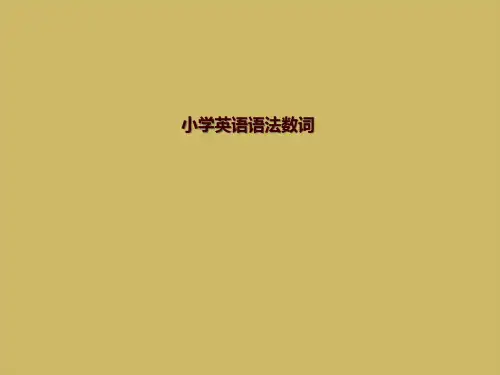
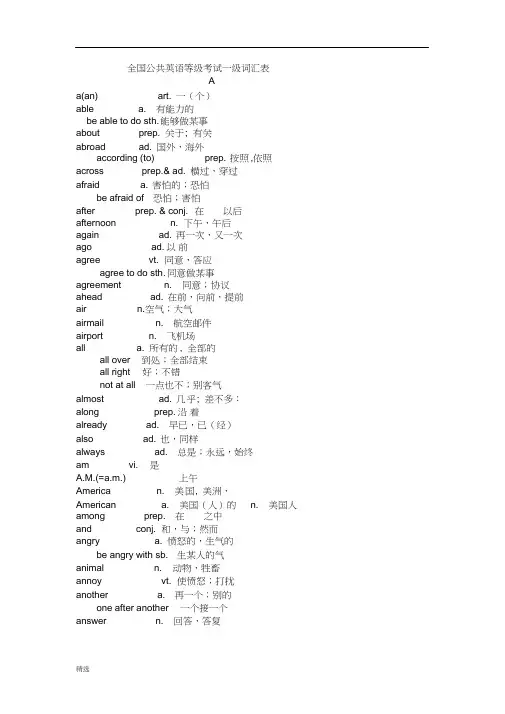
全国公共英语等级考试一级词汇表Aa(an) art. 一(个)able a. 有能力的be able to do sth. 能够做某事about prep. 关于; 有关abroad ad. 国外,海外according (to) prep. 按照,依照across prep.& ad. 横过,穿过afraid a. 害怕的;恐怕be afraid of 恐怕;害怕after prep. & conj. 在以后afternoon n. 下午,午后again ad. 再一次,又一次ago ad. 以前agree vt. 同意,答应agree to do sth. 同意做某事agreement n. 同意;协议ahead ad. 在前,向前,提前air n.空气;大气airmail n. 航空邮件airport n. 飞机场all a. 所有的, 全部的all over 到处;全部结束all right 好;不错not at all 一点也不;别客气almost ad. 几乎;差不多:along prep. 沿着already ad. 早已,已(经)also ad. 也,同样always ad. 总是;永远,始终am vi. 是A.M.(=a.m.) 上午America n. 美国, 美洲,American a. 美国(人)的n. 美国人among prep. 在之中and conj. 和,与;然而angry a. 愤怒的,生气的be angry with sb. 生某人的气animal n. 动物,牲畜annoy vt. 使愤怒;打扰another a. 再一个;别的one after another 一个接一个answer n. 回答,答复any a. 什么的;任何的anybody pron. 任何人anything pron. 任何事,什么东事apple n. 苹果are vi. 是be 的复数形式arm n. 手臂around ad. & prep. 在周围;到处arrive vi. 到达,来到arrive at in a place 到达某地as ad.同样地;一样; prep. 当时候as as 像一样not so as 和不一样ask vt. 问;请求,询问at prep. 在, 在里, 在旁at breakfast 在吃早餐at home 在家里at last 终于,最后at once 立即,马上at school 在学校at the same time 同时at work 在工作aunt n. 阿姨,姑妈, 伯母,舅母autumn n. 秋天away ad. 离开, 在远方be away from 远离, 不在gorun away 逃走Bbaby n. 婴儿back n. 背,背后,后面bad a. 坏的,严重的bag n. 袋,包ball n. 球banana n. 香蕉bank n. 银行;岸basket n. 篮子basketball n. 篮球be v. 是,在bear n.熊beat vt. 打,击beautiful a. 美丽的because conj. 因为because of 由于,因为become vt. 成为,变为bed n.床go to bed 上床睡觉make the bed 铺床beef n. 牛肉beer n. 啤酒before prep. 在之前begin vi. 开始behind prep. 在后面, 在背后believe vt. 相信bell n.钟,铃below prep. 在下面, 在以下beside prep. 在旁边best a. 最好do one’s best 尽力去做better a. 较好的had better 最好between prep. 在(两者)之间big a. 大的bike n.自行车bird n. 鸟birthday n. 生日bit n. 一点a bit (of) 一点儿black a. 黑色的blackboard n. 黑板block n. 街区;障碍物blow vi (blew, blown) 吹;打击blue a. 蓝色的boat n. 小船body n. 身体;物体book n. 书borrow vt. 借入both prep. 两者,双方bother v. 打扰bottle n. 瓶子box n. 盒子boyn. 男孩bread n. 面包break vt. 打破;中断breakfast n. 早餐bridge n.桥bright a.明亮的bring vt. 拿来, 带来brother n. 兄弟brown a. 棕色的brush n. 刷子build vt. 建筑,建立building n.建筑物,大楼bus n. 公共汽车busy a. 繁忙的be busy doing sth. 忙着做某事be busy with sth. 忙于某事but conj. 但是not only but also 不仅而且buy vt. 购买by prep. 在旁边;通过by bus car train ship plane air 乘公共汽车小轿车火车船飞机by oneself 独自;单独bye-bye int. 再见Ccall vt. & n. 电话,呼叫, 拜访can aux 能够,会;可以car n. 汽车,小汽车card 纸牌,卡片,名片careful a. 小心的, 细心的carry vt. 运送, 携带case n. 情况;事例cashier n. 出纳员cat n. 猫catch vt. 捉, 患, 赶上catch a cold 得了感冒catch up with sb. 赶上某人center (=centre) n. 中心, 中央certainly ad. 必定,当然:chair n. 椅子change vt. & n. 变化, 改变changeable a. 可变的, 易变的cheap a. 便宜的, 廉价的check (=cheque) n. 支票vi & vt. 检查,核对check in 登记,签到check out 清帐, 结算China n. 中国Chinese a. 中国的中国人的;n. 中国人, 汉语cinema n.电影院city n. 城市class n. 班, 班级classroom n. 教室close v. 关闭 a. 接近的clothes n.衣服cloud n.云cloudy a. 有云的,阴天coffee n. 咖啡coke n.可口可乐college n. 学院,大学colo(u)r n. 颜色come vi. 来company n. 公司computer n. 计算机conversation n. 对话cookn. 厨师v. 烹调, 煮cool a. 凉爽的copy n. 副本, 抄本corner n. 角落;拐角cost vt. 花费could aux. 能,可能country n. 国家;乡村countryside n. 乡下,农村cover vt. 覆盖be covered with 为所盖credit n. 信任;信用credit card 信用卡cry v. 叫喊;哭喊cup n.杯子cut vt. 切,割;剃Ddance v. 跳舞dark a. 黑暗的date n. 日期daughter n. 女儿day n. 天day after day 日复一日,连续不断地the day after tomorrow 后天dead a. 死的dear a. 亲爱的decide v.决定deep a. 深的desk n. 桌子develop vt. 发展development n. 发展dialogue n.对话dictionary n. 字典die vi. 死different a. 不同的difficult a. 困难的dig vt. 挖掘dinner n. 晚餐,正餐dirty a. 肮脏的discuss vt. 讨论dish n. 碟;菜dov.aux.&vt. 做do one’s homework 做家庭作业do some cleaning打扫卫生do some cooking做饭do some shopping 购物doctor n. 医生dog n. 狗dollar n. 美元door n. 门double a. 双倍的down ad. 下来;下面draw vt.&vi. 画;拉dress n.&vt. ( 穿)衣服drink vt.&n. 喝;饮料drive vt.. 驾驶;迫使driver n. 司机,驾驶者dry a. 干的during prep. 在的期间E each pron. 每个,各自each other 互相ear n. 耳朵;听力early a. 早的earthn. 地球,土east n. , a.&ad. 东方easy a. 容易的eat vt.&vi 吃eat up 吃光egg n.蛋eight num. 八either a.&pron. ( 两者中的)任何一个either or 或者或者eleven num. 十一else a.&ad. 其他empty a.&vt. 空的;倒空end n.终止;最后部分in the end 最终England n. 英国English a. 英国(人)的n. 英国人,英语enjoy vt. 喜欢enjoy oneself 过得快乐enough a.足够的even ad. 甚至evening n. 晚上everad. 总是;从来for ever 永远every a. 每个everybody pron. 每人everyone pron. 每人,每个everything pron. 每件事everywhere ad. 到处,处处example n. 例子except prep. 除了excusen.&vt. 借口,原谅exercise n. 练习expect vt. 期望expensive a. 昂贵的eye n. 眼睛Fface n. 脸vt.面对,面向factory n. 工厂fall vi. 落下fall ill 生病family n. 家庭famous n. 著名的far a.&ad. 遥远far away 遥远的farm n. 农场fast a. 快的father n. 父亲favo(u)rite a.特别喜爱的feel vi. 感觉few a.&pron. 不多,少数a few 几个field n. 田野;领域fifteen num. 十五fifty num. 五十fill vt. 填写;装满fill in 填写film n. 电影;胶卷find vt. 找到find out 发现fine a. 美好的finish vt. 完成fire n. 火first num. 第一ad. 首先at first 首先,最初fish n.鱼fit vt.&a. 合适five num.五flight n. 飞行, 航班floor n. 地板flowern. 花fly vi. 飞food n. 食物foot n. 英尺;脚on foot 步行football n. 足球for prep. 为了for example 例如foreign a. 外国的forget vt. 忘记form n. 形式forty num. 四十forward ad. 向前four num. 四fourteen num. 十四fourth num. 第四free a. 自由的French a. 法国(人)的n. 法国人;法语Friday n. 星期五Friend n. 朋友make friends with 与交朋友friendly a. 友好的friendship n. 友谊from prep. 从, 从来front n. 前面in front of 在前面fruit n. 水果full a. 满的be full of 充满,装满fun n. 乐趣future n. 将来G game n. 游戏, 比赛garden n. 花园gaten. 门get vi.&vt. 变得;得到get back 取回, 回来get in 进入, 到达get off 下车, 出发get on上车;get on with 与相处融洽get up 起床giftn. 礼物;天赋girl n. 女孩give (gave,given)vt. 给give back 归还giveup 放弃,认输glad a. 高兴的glass n.玻璃(杯)go (went,gone)vi. 走,离开go back 回来go for a walk 去散步go on 继续进行goto school 上学goto bed 上床睡觉good a. 好的be good at 擅长于goodbye int. 再见grade n. 等级;年级grass n. 草地great a. 大的;伟大的green a.&n. 绿色(的)ground n. 地面groupn. 组,群grow(grew,grown)vi. 生长,成长grow up 长大guess vi. 猜测guest n. 客人Hhair n. 头发half n. 一半half an hour 半小时hand n. 手vt. 传递hand in 上交happy a. 高兴的,幸福的hard a. 困难的ad. 努力地has v. 有(have 的第三人称单数现在式) hat n. 帽子have vt. 有have a good time 过得开心have a cold 得感冒have a meetingmatchrest开会比赛休息have breakfastlunchsupper吃早餐午餐晚餐have lessonsclasses上课have sports 运动haveto 不得不, 必须he pron.他head n. 头, 首领health n. 健康healthy a. 健康的hear (heard,heard)vt.&vi. 听见, 听说hear from 收到的来信heart n. 心脏learnknow sth. by heart 熟记,背诵heavy a. 重的hello int. 喂help vt&n. 帮助her prep. 她here ad. 这里here and there各处, 到处hi int. [ 表示问候或引起注意]嗨,喂high a. 高的hill n. 小山him pron. 他hobby n.业余爱好,嗜好hold (held,held)vt.&vi 抓住, 拿,抱hold a meeting 开会hold on 坚持;(打电话时)不挂断holiday n. 假期home n.家,homework n. 家庭作业hope n.&vi. 希望horse n. 马hospital n. 医院hot a. 热的hotel n. 旅店hour n. 小时house n. 房子howad. 怎样;多么hundred n. 百hungry a. 饥饿的hurry v.&n. 匆忙hurry up 快一点in a hurry 匆忙地,急忙地husband n. 丈夫II pron. 我ice n. 冰idea n. 主意if conj. 假如ill a.生病的;坏的important a. 重要的in prep. 在里面;在期间information n. 信息instead ad. 代替,顶替interest n.&vt. 兴趣, (使) 感兴趣interested a. 感兴趣的interestinga. 有趣的,引起兴趣的intoprep. 到里, 进入;成为is v. & aux 是, 存在it prep. 它its pron. 它的J join vi. 加入juice n. 果汁July n. 七月Jump vt.,vi.&n. 跳跃June n. 六月just ad. 刚刚,方才just now 刚才;现在Kkeep (kept,kept)vt. 保持keep on doing sth. 一直做某事key n. 钥匙kilogramme n.公斤,千克kind a. 善良的, 亲切的n. 种类, 类别a kind of 一种all kinds of 各种各样kitchen n. 厨房knife n.刀knock v.&n. 敲打;碰撞know vt. 知道,认识Llake n.湖land n. 陆地language n. 语言large a. 大的last a. , ad.&n. 最后(的)at last 终于late a. 迟的, 最后的be late for (school) 上学迟到laugh vi.&n. 笑laugh at 嘲笑league n. 联盟,社团League Member 团员learn (learnt,learnt;leaened,learned)vt.&vi 学习leave (left,left)vt. 离开left a. 左边的leg n. 腿lend vt. 借出lesson n.功课;教训doone’s lessons 做功课have lessons上课let vt. 让,允许letter n. 信;字母library n. 图书馆lie vi. 躺, 位于life n. 生命light a. 轻的n. 灯火like prep. 像一样vt. 喜欢shouldwould like 想(做某事)listen vi. 听listen to 倾听little a.很少的; n. 少量, 少许a little 一点点live vt.&vi 生活;居住long a. 长的vi. 渴望no longer 不再, 再也不not any longer 不再,再也不look vi.&n. 看look after 照顾, 照料look at 看look for 寻找look forward to 盼望,期待look up (在字典等中)查寻lot n. 许多a lot of 大量,许多,很多lots of 大量, 许多,很多love n.&vt. 热爱,爱好lovely a. 可爱的low a. 低的lunch n. 午餐M machine n. 机器mail n.&vt. 邮递make (made, made)vt.制造;使make a mistake 犯错误makea noise 发出声(噪)音man n. 男人manager n. 经理manya 许多的,多的map n. 地图market n. 市场match n.比赛;火柴matter n. 事情,情况vi 有关系may v. aux. 可能,也许,可以maybe ad. 大概,或许me pron. 我[I 的宾格]meal n. 膳食,一餐mean vt. 意味着, 想要,预定meat n. 肉medicinen. 药meetvt. 会见,遇见meeting n. 会议member n. 成员mend vt. 修理mention vt. 提及,说起,谈到meter (=metre)n. 米,公尺middle n. 中间,当中 a. 中间的in the middle of 在中间milk n. 牛奶mind n. 头脑,想法,意见vt. 介意,留心mine pron. [ 物主代词] 我的(东西)mineral a.&n. 矿物(的)minute n. 分钟missvt. 错过;思念Miss n. 小姐mistake n. 错误modern a. 现代的moment n. 时刻,片刻Monday n. 星期一money n. 金钱,货币month n. 月份,月moonn. 月亮,月球more a.,ad.&n. 更多morning n. 早晨,上午most a. ,ad.&n. 最,非常mother n. 母亲mouth n. 嘴move vt.&vi. 移动Mr. (=Mister)n. 先生Mrs. (=Mistress)n. 太太,夫人much (more,most) n.&a 许多,大量ad. 非常music n. 音乐must v. aux. 必须,应当,一定my pron. 我的[I 的所有格]myself pron. 我自己[ 反身代词]Nname n.&vt. (取)名字near a.&ad. 接近prep. 靠近nearly ad. 几乎,差不多necessary a. 必要的,必须的need n. ,v.&v.aux. 需要neither a.&pron.(两者)都不neither nor 既不也不never ad. 永不,决不new a. 新的news n.新闻,消息next a.&ad. 紧接的,其次的,然后nice a. 好的,令人愉快的night n. 夜晚nine num.九no a.&ad. 不,不是,没有nobody pron. 没有人noisen. 噪音,noon n.正午,中午nor conj.&ad. 也不,也没有north n.&a. ,ad. 北方nose n. 鼻子not ad. 不not at all 别客气,毫不,一点也不note n.笔记,记录;v. 注意noting n. 没有东西now ad. 现在from now on 从现在开始number n. 数字a number of 许多nurse n. 护士Oo’clock ad. 点钟of prep. 的of course 当然off prep.&ad. 离开office n. 办公室oftenad. 经常oh int. 啊,唉OK a.很好的old a. 年老的on prep. 在之上and so on 等等once ad. 曾经conj. 一旦at once 立刻,马上once upon a time 从前one pron. 一个num. 一one by one 一个接一个,接连only a.&ad. 仅仅open vt.& a.. 开(的)or conj. 或者;否则orange n.&a. 橙色(的)order n.&vt. 命令;秩序other a.&pron. 其他the other(s) 其他our pron. 我们的out ad. 在外面的out of 在之外,缺乏outside over ownn.,a.&ad. 在外面prep. 在上面,超过a. 自己的vt. 拥有Ppage n.页,张pair n.双,对a pair of 一对,一双palace n. 宫殿the Summer Palace颐和园paper n. 纸pardon n.&vt. 原谅parent n.父亲,母亲park n. 公园vt. 停放part n. 部分take part in 参加party n. 党;晚会Party Member 党员pass vt. 通过passage n. (文章等的)一段,一节passenger n. 过路者;行人passportn. 护照past n. 过去prep. 经过pay (paid,paid) vt.&n. 报酬pay for sth. 给某人报酬pen n. 钢笔pencil n. 铅笔people n. 人们,人民per prep. 每,每一perfect a. 完美的person n.人photo n. 照片piano n. 钢琴pick vt. 挑选,拾,摘picture n. 画,照片,影片piece n. 片,块a piece of 一片(块)pioneer n. 先驱者,开拓者,先锋the Young Pioneers少年先锋队pity n. 同情,可怜placen. 地方,地点plan n.&vt. 计划,打算plane n. 飞机plant n.&vt. (种)植物plate n. 盘子play n. 戏剧vt.&vi. 玩;演奏please vt. 使愉快,使高兴pleasure n. 愉快,快乐,乐趣policeman n. 警察polite a. 有礼貌的poor a. 贫穷的pork n. 猪肉possible a.可能的post vt. 邮寄post office 邮局potato n.马铃薯practice n.练习,实习present a. 现在的,出席的n. 礼物,目前price n.价格,价钱problem n. 问题pull vt. 拉,拖pupil n. (小)学生push vt. 推put vt. 放置,摆put on 穿(衣)put sth.down 记下某事put up 提出Qquarter n. 四分之一;一刻钟question n. 问题quick a. 快的quiet a. 安静的,平静的quite ad. 十分,相当Rradio n. 收音机railway n. 铁路rainn.&vi. (下)雨raise vt. 升高;增加read (read read) vt.&vi. 阅读ready a. 乐意的,准备好的be get ready (for) 做好准备really ad. 确实,实在reason n.理由,原因receipt n.收据,收条receive vt. 收到,接到red n.&a. 红色(的)remember vt. 记住,记得report vt.&n. 报告,报道rest n.&vi. 休息takehave a rest休息一下restaurant n. 餐馆,饭店return v&n. 回来,归还rice n. 大米rich a. 富有的ride (rode ridden ) vi.&vt. 骑right a. 正确的;右边的;n. 右边;权利all right 好吧ring (rang rung ) vi.&n, (按)铃ring up 打电话river n.江,河road n. 道路room n. 房间round a. 圆的run (ran run )vi. 跑Ssad a. 忧愁的,悲伤的same a. 一样的Saturday n. 星期六say (said said )vt.&vi. 说,说明school n. 学校science n. 科学sea n. 海洋season n. 季节seat n. 座位vt. 使坐下second a. 第二的num. 第二n. 秒secretary n. 秘书see (saw seen) vt. 看见see sb. off 给某人送行seem vt. 仿佛,好像,似乎sell vt. 卖send (sent sent) vt. 送,寄send for 请(医生)serve vt. 服务,招待service n. 服务set n. 一套,一副vt. 放,安置set up 建立,创立sevennum. 七several a. 几个的shall v.aux. 将;会she pron. [主格]她sheep (单复数同形) n. 绵羊shine (shone shone )vi. 照耀ship n. 轮船shirt n. 衬衫shoe n. 鞋子ship n. 商店shop-assistant n. 售货员short a. 短的,矮的should v.aux. 应该shout vt.&n. 呼叫,呼喊show vt. 表示,显示n. 展览sick a. 病的side n.旁边;一边by the side of 在旁边silk n. 丝绸similar a. 相似的,类似的simple a. 简单的simply ad. 仅仅,只不过since prep.自从,自以来conj.因为,既然sing (sang sung )vt. 唱歌single a. 单个的,单身的sir n. 先生sister n. 姐妹sit (sat sat )vi. 坐six num. 六sixteen num. 十六size n.尺寸,大小skirt n. 裙子sky n. 天空sleep (slept slept) vi. 睡觉go to sleep 去睡觉slow a. 慢的small a. 小的smell (smelt smelt ) n. 气味v.闻,嗅smile n.&vi. 微笑smoke n.&vi. ( 吸)烟snow n.&vi. (下)雪so ad. 那么conj. 因此,那么soldier n. 士兵some a.&pron. 一些,若干somebody pron. 某人someone pron. 某人something pron. 某事;某物sometimes ad. 有时候somewhere ad. 在某处son n. 儿子song n.歌soon ad. 不久as soon as一就, 刚便sorry a. 抱歉的;遗憾的sound n. 声音south n. 南方spare a. 多余的,备用的speak (spoke spoken )vi.&vt. 说spend (spent spent )vt. 花费sport n. 运动spring n. 春天stamp n. 邮票stand (stood stood ) vi. 站立star n. 星start vt. 开始station n. 车站stay vi. 停留still ad. 仍然stop vt. 停止stop sb. from doing sth. 阻止某人做某事store n. 商店story n. 故事straight a. 直的strange a. 奇怪的street n. 街道strong a. 强壮的student n. 学生studyvt. 学习subject n. 科目,主题such a.如此的, 这样的such as 例如sugarn. 糖suggest vt. 建议suggestion n. 建议summer n. 夏天sun n. 太阳Sunday n. 星期日sunny a. 晴天的supermarket n. 超级市场supper n. 晚餐sure a. 确定的,确实的surface n. 表面surface mail 普通邮件surprise vt.&n. (使)惊讶sweet a. 甜的swim (swam, swum) vi.&n. 游泳Ttable n. 桌子take vt. 拿,取take a walkrest 散步休息take away 拿走,收拾takeout 拿出take downoff 取下脱下take the trainboatbus 乘火车船公共汽车talk vi.&n. 谈话,谈论tall a. 高的taxi n. 出租车tea n.茶teach (taught, taught) vt. 教teacher n. 教师telephonen. 电话television (=TV) n. 电视tell (told, told) vt. 告诉ten num.十tennis n. 网球text n. 课文than conj. 比thank n.&vt. 谢谢that pron. 那个the art. 那, 这their pron.他们的them pron. [ 宾格]他们then ad. 当时,那时;然后there ad. 那里these pron. 这些they pron. (主格)他们thin a. 瘦的;薄的thing n. 东西think (thought, thought) vt. 思考,考虑think about 考虑thirsty a. 口渴的thirteen num. 十三thirty num. 三十this pron. 这个those pron. 那些though conj. 虽然,即使three num. 三through prep. 通过,穿过throw (threw, thrown) vt.投,抛,扔Thursday n. 星期四ticket n. 票till prep.&conj. 直到time n. 时间all the time 一直,始终in time 及时on time 准时tired a. 疲倦的to prep. 向,达到,today n. &ad. 今天togetherad. 一起地,同时的tomorrow n.&ad. 明天tonight n.&ad. 今晚too ad. 也;太too to 太以致不tooth ([pl.] teeth) n. 牙齿tourist n. 游客town n.镇train n. 火车travel n. 旅行travel(l)er n. 旅客tree n. 树trip n. 旅行trouble n. 麻烦true a. 真的try vt.&n. 尝试try on 试(穿)Tuesday n.星期二turn vt.&vi. 旋转,转变turn off 关turn on 开twelve num. 十二twenty num. 二十twice ad. 两次,两倍two num. 二Uumbrella n. 雨伞uncle n. 叔叔,舅舅,姑父under prep. 在下面underground ad. 地下understand (understood, understood) vt.&vi. 懂,理解until prep.&conj. 直到up prep.&ad. 在上up and down 上上下下;来回地us pron.我们[宾格]use vt.&n. 使用,利用usually ad. 通常Vvegetable n. 蔬菜very ad. 很,非常village n. 村庄visit n.&vt. 访问,参观Wwait vi. 等待,等候wait for 等待wake (woke, woken) vi. 醒wake up 醒来walk vi.&n. 走,散步wall n.墙the Great Wall 长城want vt. 想要warm a. 温暖的wash vt.&n. 洗watch vt. 观看n. 手表water n. 水way n.道路;方法,手段by the way 顺便on theone ’s way t在o途中,在的路上we pron.我们[ 主格]wear (wore, worn) vt. 穿,戴weather n. 天气week n. 星期weekend n. 周末welcome n.&vt. 欢迎well a.&ad. 好的west n.西方western a. 西方的wet a. 湿的what pron. 什么when ad.&conj. 什么时候where pron. 哪里whether conj. 是否which pron. 哪一个while conj. 当时候white n.&a.白色(的)who pron. 谁whom pron.谁[宾格] whose pron. 谁的why ad. 为什么wide a. 宽的wife n. 妻子will v.aux. 将要wind n.风window n. 窗子winter n. 冬天wish vi.&n. 希望,愿望with prep. 和一起without prep. 没有woman n. 妇女word n. 单词;言语work n.&vi. 工作at work 在工作中worker n. 工人world n. 世界worry vi.&n. 担忧,发愁worth n. 价值 a.值得的would v.aux. 将要write (wrote, written) vt. 写write down 写下wrong a. 错误的,不对的be wrong with 有毛病,有故障Yyear n.年yellow n.&a. 黄色(的)yes ad. 是的yesterday n.&ad. 昨天yet ad. 仍然you pron.你[主格] young a. 年轻的your pron. 你的yours pron. 你的(东西)yourself pron. 你自己Zzero n.零zoo n. 动物园。
小学英语词汇分类表一级(三四年级)1性别及家庭成员boy 男孩girl 女孩mother 母亲father 父亲grandpa 爷爷grandma 奶奶grandmother 祖母、外祖母grandfather 祖父、外祖父dad 爸爸mum 妈uncle 叔叔aunt 婶、姑、姨sister 姐、妹brother 兄、弟Ms 女士Mr 先生Miss 小姐parent(s)父母之一(双亲)2动物panda 熊猫monkey 猴子dog 狗cat 猫bird 小鸟bee 蜜蜂bear 熊horse 马pig 猪duck 鸭子rabbit 兔子tiger 老虎lion 狮子chick 小鸡fox 狐狸hen 母鸡cock 公鸡donkey驴子,笨蛋hippo河马cow母牛ox牛,公牛peacock孔雀sheep绵羊wolf狼wing翅膀tail尾巴3数字one 一two 二three 三four 四five 五six 六seven 七eight 八nine 九ten 十eleven 十一twelve 十二thirteen 十三fourteen 十四fifteen 十五sixteen 十六seventeen 十七eighteen 十八nineteen 十九twenty 二十twenty-one 二十一thirty 三十forty 四十fifty 五十sixty 六十seventy 七十eighty 八十ninety 九十one hundred 一百thousand一千first第一second第二third第三4食物饮料三餐味道水果rice 米饭meat 肉noodles 面条fish 鱼chocolate 巧克力egg 蛋vegetable 蔬菜carrot 胡罗卜bread 面包orange 橘子apple 苹果milk 牛奶tea 茶coffee 咖啡cake 蛋糕candy 糖果cookie 小甜饼hot dog 热狗breakfast 早餐lunch 午餐supper 晚餐dinner 正餐lemon 柠檬pear 桃子peach 桃子,桃树banana 香蕉dumpling饺子beef牛肉tofu豆腐cabbage卷心菜lettuce生菜carrot胡萝卜salad色拉,沙拉water水juice汁orange juice橙汁apple juice苹果汁cola可乐pie派apple pie苹果派ice cream冰淇凌hungry饥饿thirsty口渴litchi荔枝picnic野餐mango芒果watermelon西瓜sweet甜的bitter苦的sour酸的hot辣的,热的spicy辛辣的yucky令人讨厌的,难吃的yummy美味的nice好的delicious美味的5衣服T-shirt 男衬衫shirt 男衬衫skirt 女裙cap 便帽hat 帽子shoes 鞋shorts 短裤vest 背心pants 裤子;男用短衬裤dress 女服;(统指)服装socks袜子trousers裤子jeans牛仔裤pocket口袋jacket夹克sweater毛衣6冠词a 一(个)an 一(个)the 这(个)7代词I 我me 我my 我的you 你you 你们your你(们)的he 他him 他his 他的she 她her 她的her 她we 我们us 我们our 我们的you 你you 你们your 你们的they 他(她)们them 他们their 他们的it 它it 它its 它的this 这that 那these 这些those 那些8疑问词what 什么what time 什么时间what day 什么日子what color 什么颜色which 哪which one 哪一个who 谁why 为什么when 什么时间where 哪儿how 怎样how old 多大(年龄)how many 多少9介词up 向…上down 向…下on 在…上under 在…下in 在…里面at 在…into到...里out of在...外before在...之前behind在...之后10时间日期o’clock …钟clock 钟watch 表day 天week 周month 月year 年hour 小时spring 春天summer 夏天autumn 秋天winter 冬天am 上午pm 下午Monday 星期一Tuesday 星期二Wednesday 星期三Thursday 星期四Friday 星期五Saturday 星期六Sunday 星期天January 一月February 二月March 三月April 四月May 五月June 六月July 七月August 八月September九月October 十月November 十一月December 十二月quarter四分之一,一刻钟11、节日Teachers’ Day 教师节New Year’s Day 新年Mother’s Day 母亲节Father’s Day 父亲节Christmas 圣诞节Children’s Day儿童节summer holiday暑假winter holiday寒假12国家语言及首都China 中国chinese 中文、汉语Beijing 北京England 英格兰、英国English 英语London 伦敦the USA 美国America 美国Britain英国Canada加拿大Australia澳大利亚New York纽约Sydney悉尼13身体部位head 头hair 头发eye 眼睛ear 耳朵nose 鼻子face 脸mouth 嘴hand 手arm 肩膀leg 腿foot 脚long长的short短的fat胖的thin瘦的strong强壮的young年轻的old老的,旧的happy快乐的,幸福的shy害羞的friendly友善的sad悲伤的quiet安静的angry生气的hungry饥饿的thirsty口渴的14 学校homework 家庭作业classroom 教室teacher 老师ruler 尺子pencil 铅笔pencil-box 铅笔盒knife 小刀eraser 橡皮檫pen 钢笔desk 课桌chair 椅子floor 地板blackboard 黑板computer 计算机English英语Maths数学Music音乐Chinese中文,汉语,中国人P.E.体育drawing美术exercise练习,习题school学校playground操场school boy校园男孩school girl校园女孩student学生pupil小学生pencil sharpener铅笔刀pencil-case铅笔盒ballpen圆珠笔table桌子ceiling天花板bottle瓶子ink墨水name名字letter信,字母box盒子schoolbag书包paper纸exercise-book练习本picture图片stamp邮票map地图tape磁带recorder录音机monitor班长15职业doctor 医生driver 司机singer 歌唱家;歌手farmer 农民nurse 护士teacher 教师worker 工人waiter 男服务员policeman警察policewoman女警察officer政府官员clerk职员, 办事员, <美> 店员visitor访问者, 来宾,游客16 反义词big/ small 大/小long /short 长/短cold /hot 冷/热thin/ fat 瘦/胖heavy /light 重/轻happy/ sad 快乐/悲伤many/ few/little 许多/一些/少的clean/ dirty干净/脏的open/ close开/关good/ bad 好/坏wet /dry 潮湿/干燥new/ old 新/旧old /young 老/新tall/ short 长/短down/ up 向下/向上slow /fast/quick 慢/快/迅速17 颜色blue 蓝色的white 白色的black 黑色的green 绿色的yellow 黄色的red 红色的orange 橙色的brown棕色pink粉红色purple紫色18形状square正方形circle圆star星形line线heart心形round圆,圆的,19 地点park公园zoo动物园city城市village乡村, 村庄garden花园street街道road路bank银行, 堤, 岸,hospital医院shoe store鞋店flower shop花店toy store玩具店bookstore书店post office邮局bus stop汽车站office办公室supermarket超级市场factory工厂field田地, 牧场home家house房子kitchen厨房room房间bedroom卧室sitting room起居室bathroom浴室toilet厕所, 梳妆lady’s room女厕所women’s room女厕所men’s room男厕所20 玩具toy train玩具火车teddy bear玩具熊doll洋娃娃toy plane玩具飞机toy car玩具小汽车robot机器人balloon气球21体育运动basketball篮球football足球volleyball排球table tennis乒乓球high jump跳高skating溜冰skiing滑雪swimming游泳22 交通工具car 小汽车bus 公共汽车bike 自行车plane 飞机train 火车taxi 出租汽车23天气和温度sunny 晴朗的cloudy 多云的windy 有风的rainy 下雨的snowy 下雪的cold 寒冷;感冒cool 凉爽,的warm 温暖的hot 热的nice 令人愉快的24 房间及物品bedroom 卧室shop 商店hospital 医院computer 计算机bed 床light 光,灯sofa 沙发chair 椅子desk 书桌table 桌子cup 茶杯bowl 碗wall 墙door 门window 窗户floor 地面plate盘子glass 玻璃杯glasses眼镜bag袋子handbag手提包TV 电视TV set电视机doorbell门铃25 其它too也good好better比…好best 最好bad坏may可以can能can’t不能26 其它形容词wonderful 美妙的;了不起的beautiful 漂亮的cool 凉爽的glad 高兴的nice 令人愉快的welcome 受欢迎的good 好的a little 一点every 每一个last 最后的slow 慢的lovely 可爱的ready 准备好的sorry 抱歉的bad 坏的clever 聪明的broken 弄坏了的fun 兴趣;有趣的事funny 搞笑的;滑稽的interesting 感兴趣的tired 累的kind和蔼的, 亲切的middle中间的, 中部的last最后的slow慢的cute可爱的bored无聊的27其它名词park 公园zoo 动物园candle 蜡烛rainbow 彩虹sea 大海river 河hill 山tree 树grass 草glass 玻璃flower 花garden 花园sky 天空star 星星the moon 月亮the sun 太阳street 街道road 路card 卡片day 天radio 收音机story 故事a phone cal l 一个电话boat 小船call 喊;叫;打电话toy 玩具left 左边right 右边party 聚会phone 电话phone number 电话号码plant 植物sport 运动way 路word 词,单词city 城市front 前面back后面holiday 假日world 世界key 钥匙letter 信bed 床village乡村, 村庄cartoon卡通片man男人woman女人lady女士party宴会,晚会,社交会left左right右,正确ice冰28 动词及短语can 能may 可以will 愿意want 想excuse 原谅find 找到fly 飞see 看见watch 看见hear 听read 读write 写run 跑jump 跳(高)swim 游泳wish 希望buy 买sell 卖drink 喝take 带(走)bring 带(来)clean 干净dance 跳舞sing 唱歌draw 画画come 来go 去give 给予play 玩;打look 看listen 听do 做like 喜欢open 开close 关wash 洗stop 停use 使用borrow 借lend 借wait 等待water 浇水work 工作ask 问answer 答get 得到drive 开,驾驶(汽车、飞机)make 做,制造put 放pull 拖、拉push 推ride 骑sit 坐stand 站speak 说say 说tell 告诉think 想row .划call 喊;叫;打电话eat 吃plant 种植live 生活study 学习visit 参观;访问worry 担心help 帮助love 爱pass 传;递rain 下雨snow 下雪blow 吹laugh 笑cry 哭will将要be going to 计划,打算,将要would like愿意,想teach教listen to听look for寻找learn学习go home 回家go to school 上学go swimming 游泳go fishing 钓鱼play basketball 打篮球play football 踢足球play a game玩游戏play the guitar 弾吉他play the piano 弹钢琴read a book 看书,读书read a letter 读信write a letter 写信listen to the teacher 听老师讲listen to me 听我讲listen to the radio 听收音机watch TV 看电视wash your face 洗脸wash your hands 洗手sing a song 唱歌do my homework 做家庭作业clean the classroom 打扫教室go to bed 睡觉by taxi 乘出租汽车;打的by air 乘飞机by plane乘飞机by bus 乘公共汽车by bike 骑自行车by train 坐火车by ship 坐轮船by car 乘汽车on foot 走路Merry Christmas 圣诞快乐come out 出来come in 进来come on 赶快in English 用英语in Chinese 用汉语Excuse me 对不起make friends 交朋友make a cake 做蛋糕go and see 去看看happy birthday 生日快乐have breakfast 吃早饭have lunch 吃午饭have dinner 吃饭have a good time 过得愉快in the morning 在早晨in the afternoon 在中午in the evening 在晚上in the desk 在桌上at night 在晚上at 9 o’clock 9点整Don’t be late 不要迟到Learn from 向…学习Let’s go home 让我们回家Let’s go to school 让我们去学校look at 看look for 寻找a map of China 中国地图Welcome to our school欢迎来我们学校Welcome to China 欢迎来中国Welcome to my home欢迎来我家Thank you 谢谢You’re welcome 不用谢over there 在那边ask a question问问题answer the question回答问题very much 很,非常a cup of tea 一杯茶a glass of water 一杯水a cup of coffee 一杯咖啡a bowl of rice 一碗米at home 在家at school 在学校buy some food 买些食物buy a jacket 买件夹克Class 3 Grade 5 5年级3班do one’s homework 做作业get up 起床come from 从…来go to work 上班I’m afraid 我害怕In the library 在图书馆Look like 看上去像sing a song 唱歌water the flowers 给花浇水drink some water 喝水after school 放学后all right 好的be going to(do) 准备去做…be out 在外;不在…bus driver 公交车司机come in 进来come out 出去go out 出去go to the cinema 去看电影go to the doctor 看医生have a cold 感冒have a look 看一看have a good idea 有主意in bed 睡觉I don’t know 我不知道play cards 打扑克play the piano 弹钢琴be quiet 安静sit down 坐下stand up 起立tell a story 讲故事That’s great 好极了take off 脱下turn on 打开turn off 关掉turn up 出现;找到;证明是turn down 关小all the time 一直fall down 落下来put on 穿上the Great Wall 长城get in 进入;上车get off 下车had better 最好have no idea 没有主意listen to 听look up 查寻next time 下次Don’t worry 别担心after class 下课后take some medicine吃药say hello to sb 对某人打招呼Tian An Men Square天安门广场yesterday morning昨天早上all right 对的,正确的every day 每天Who’s on duty? 今天谁值日Follow me, please. 请跟我来get home 到家go for a walk 散步go shopping 去买东西on duty 值日I’m tired 我累了Let me try 让我试试in the world 在世界上go cycling骑自行车play table tennis打乒乓球take a picture照相ride a bike骑自行车turn right向右转turn left向左转wash clothes洗衣服do morning exercises做早操ride a horse骑马go fishing钓鱼hand in hand手拉手have a rest休息have nothing什么也没有hurry up快点,快at half past twelve12:30look out of向…外看Look out!当心go to see a doctor去看医生Welcome to our school 欢迎到我们学校a lot of许多a bottle of orange juice一瓶橙汁a bottle of beer一瓶啤酒clean the classroom打扫教室do homework做作业draw a picture画画get up early早起come from America来自美国*help yourself to some fish吃些鱼run very fast跑得快show me your ticket出示你的票wait for the bus等公共汽车wait for the train等火车would like愿意,想*be bad for对…不好/有坏处drive a car开车get ready 准备好have a fever发烧have a headache头痛have a stomachache肚子痛,胃痛post office邮局bus station汽车站railway station火车站What’s wrong with you/he…?你/他…怎么了?a phone call一个电话all the time所有时间row a boat划船fall down跌倒,倒下put on穿上go shopping 购物the Great Wall长城the Summer palace颐和园get to到达go by走过,乘…去worry about担心a flower show花展all the same全都一样,仍然arrive at/in到达help sb.(somebody)with用…帮助某人It’s very kind of you你太好了just now刚才last night昨天晚上last Saturday上个星期六two weeks ago两周以前with pleasure愉快的,愿意all right好at the weekend周末Beijing Opera京剧go for a walk散步It’s my pleasure不客气,是我的荣幸in the world世界上29习惯用语Good morning/afternoon/evening.早晨/中午/晚上好How are you?你好吗Fine , thank you. 好的,谢谢你Not bad , thank you.好的,谢谢你Welcome come backto school欢迎回到学校来Happy birthday!生日快乐What’s your name,please?请问,你的名字是什么Your name, please?请问,你的名字是什么My name is….I’m ….我的名字是…我是…This isMiss/Mr/Mrs….这是…小姐/先生/女士This is my friend. 这是我的朋友Come and meet myfriends.过来见见我的朋友How do you do? 你好吗Nice to meet/see you很高兴认识你Goodbye! 再见Good night!晚安How old are/is …? …多大几岁?Thank you./Thanks.谢谢You’re welcome. 你太客气了/不用谢That’s all right. 不用谢I’m sorry. 我很抱歉Sorry, I don’t know.对不起,我不知道Excuse me.对不起,打扰一下May I come in? 我能进来吗?Come in, please.请进Have some bananas, please.请吃点香蕉It’s time for lunch 该吃午饭了.May I use your pen? 我能用一下你的钢笔吗Can I have two cakes? 我能吃两块蛋糕吗No, you can’t.不,你不能Can I have one, please?我能吃一个吗Yes. / All right.是的,好的Here you are.给你Can I go with you?我能和你一起去吗?Sure!当然Are you sure?你肯定?Yes, I’m sure.是的,我肯定You’re wrong. 你错了You’re right. 你是对的I like it very much.我非常喜欢I like drawing pictures 我喜欢画画Can I help you?我能帮助你吗?What do you want, adress or a skirt?你想要什么,连衣裙还是短裙?How about the blueone?这件蓝色的怎么样?How much is it? 多少钱?Fifty yuan, please. 50元,谢谢。
一.性别及家庭成员1. boy男孩2. girl女孩3. mother妈妈,母亲4. father父亲,爸爸5. grandpa,爷爷,外公6. grandma奶奶,外婆7. grandmother(外)祖父8. grandfather(外)祖母9. dad爸爸10. mum妈妈11. uncle叔叔,伯父12. aunt阿姨,婶婶,伯母13. sister妹妹,姐姐14. brother兄,弟15. Ms女士16. Mr先生17. Miss小姐(未婚)18. Mrs 夫人,太太(已婚)二.动物19. panda熊猫20. monkey猴子21. dog狗22. cat猫23. bird鸟24. bee蜜蜂25. bear熊26. horse马27. pig猪28. duck鸭子29. rabbit兔30. tiger老虎31. lion狮子32. chick小鸡33. fox狐狸,欺诈34. hen母鸡35. cow奶牛,母牛36. cock公鸡三.数字37. zero 零38. one一39. two二40. three三41. four四42. five五43. six六44. seven七45. eight八46. nine九47. ten 十48. eleven十一49. twelve十二50. thirteen十三51. fourteen十四52. fifteen十五53. sixteen十六54. seventeen十七55. eighteen十八56. nineteen十九57. twenty二十58. twenty-one二十一59. thirty三十60. forty四十61. fifty 五十62. sixty六十63. seventy七十64. eighty八十65. ninety九十66. one hundred一百67. first第一68. second第二69. third第三70. forth第四71. fifth第五72. sixth第六73. seventh第七74. eighth第八75. ninth第九76. tenth第十四.食物饮料三餐味道水果77. rice 米饭,稻米78. meat 肉79. noodles面条(复数)80. fish鱼、鱼肉81. chocolate巧克力82. egg鸡蛋83. vegetable蔬菜84. carrot胡萝卜85. bread面包86. orange 桔子,橙色的87. apple 苹果88. milk牛奶89. tea茶,茶叶90. coffee咖啡91. cake蛋糕92. candy糖93. cookie饼干94. hot dog热狗95. breakfast早饭96. lunch午饭97. supper晚饭98. dinner正餐99. lemon柠檬100. pear梨子101. peach桃子102. banana香蕉五.衣服103. T-shirt体恤衫104. shirt衬衫105. skirt短裙106. cap帽子107. hat帽子108. shoes鞋109. shorts(运动)短裤110. vest背心111. pants短裤,内裤,112. dress连衣裙六.冠词113. a一(个,件……)114. an一(个,件……)115. the这,那个,这,那些七.代词116. I我(主格)117. me我(宾格)118. my我的119. you你(主格)120. you你(宾格)121. your你的122. he他(主格)123. him他(宾格)124. his他的125. she她(主格)126. her她(宾格)127. her好的128. we我们(主格)129. us我们(宾格)130. our我们的131. you你们(主格)132. you你们(宾格)133. your你们的134. they他们(主格)135. them他们(宾格)136. their他们的137. it它(主格)138. it它(宾格)139. its它的140. this这,这个141. that那,那个142. these这些143. those那些八.疑问词144. what什么145. what time什么时候146. what day星期几147. what color什么颜色148. which 哪一(个,件…)149. which one哪一(个,件…)150. who谁151. why为什么152. when何时153. where哪里154. how多么,怎样155. how old多大,多少岁156. how many多少(用于可数名词复数)九.介词157. up向上158. down向下159. into向……里160. out of向……外161. on在……上162. under在……下163. in在……里164. at在……十.时间日期165. o’clock点钟166. clock钟167. watch手表168. quarter刻钟(15分钟)169. half past……点半170. day白天,日子171. week用172. month月173. year年174. hour小时175. spring春天176. summer夏天177. autumn秋天178. winter冬天179. am上午180. pm下午181. Monday星期一182. Tuesday星期二183. Wednesday星期三184. Thursday星期四185. Friday星期五186. Saturday星期六187. Sunday星期天188. January一月189. February二月190. March三月191. April四月192. May五月193. June六月194. July七月195. August八月196. September九月197. October十月198. November十一月199. December十二月十一、节日200. the Spring Festival春节201. Teachers’Day教师节202. National Day国庆节203. New Year’s Day新年204. Mother’s Day母亲节205. Father’s Day父亲节206. Christmas圣诞节十二国家语言及首都207. China中国208. Chinese209. 中国人,中国的,汉语210. Beijing 北京211. England英国212. English213. 英国人,英国的,英语214. London伦敦215. the USA美国216. America美国十三.身体部位217. head 头218. hair头发,毛发219. eye眼睛220. ear耳朵221. nose鼻子222. face脸223. mouth嘴224. hand手225. arm手臂,胳膊226. leg腿227. foot脚(单数)feet(复数)十四. 学校228. English英语229. Maths数学230. Music音乐231. Homework家庭作业232. Chinese语文233. School学校234. Classroom教室235. Swimming游泳236. Playground操场237. school boy男学生238. school girl女学生239. student学生240. teacher教师241. sharpener卷笔刀242. ruler尺子243. pencil铅笔244. pencil-box铅笔盒,文具盒245. pencil-case铅笔袋,笔袋246. knife小刀247. eraser橡皮擦248. pen钢笔249. ballpen圆珠笔250. desk课桌,办公桌251. chair椅子252. floor地板253. blackboard黑板254. computer电脑十五.职业255. doctor医生256. driver司机,驾驶员257. singer歌手258. policeman男警察259. policewoman女警察260. farmer农民261. nurse护士262. teacher教师263. worker工人264. waiter服务员十六. 反义词265. big/ small大的/小的266. long /short长的/短的267. cold /hot冷的/热的268. thin/ fat瘦的/胖的269. heavy /light重的/轻的270. happy/ sad高兴的/伤心的271. many/ few/little很多/少量/少量272. clean/ dirty干净的/脏的273. open/ close打开/关上274. good/ bad好的/坏的275. wet /dry湿的/干的276. new/ old新的/旧的277. old /young年老的/年轻的278. tall/ short高的/短的279. down/ up向下/向上280. slow /fast/quick十七. 颜色281. blue蓝色的282. white白色的283. black黑色的284. green绿色的285. yellow黄色的286. red红色的287. orange橙色的十八.体育运动288. basketball蓝球289. football足球290. table tennis乒乓球291. high jump跳高292. skating滑冰293. swimming游泳十九.交通工具294. car小汽车295. bus公共汽车296. bike自行车297. plane飞机298. train火车299. taxi出租车二十.天气和温度300. sunny阳光充足的301. cloudy有云的302. windy有风的303. rainy有雨的304. snowy有雪的305. cold寒冷的306. cool凉爽的307. warm温暖的308. hot炎热的309. nice好的二十一. 房间及物品310. house房子311. room房间312. bedroom卧室313. classroom教室314. shop商店315. bookstore书店316. shoes tore鞋店317. flower store花店318. bank银行319. hospital医院320. picture图画,照片321. computer电脑322. bed床323. light灯324. sofa沙发325. chair椅子326. desk课桌327. table桌子328. cup茶杯329. glass玻杯330. bowl碗331. TV电视332. Wall墙333. Door门334. Window窗户335. Floor地板二十二. 其它形容词336. wonderful精彩极了的337. beautiful美丽的338. cool凉爽的339. glad高兴的340. nice好的,美丽的341. welcome受欢迎的342. good好的343. a little一点344. every每一个的345. last最后346. slow慢慢的347. lovely可爱的348. ready乐意的349. sorry报歉350. bad坏的351. clever聪明的352. broken弄坏的353. fun有趣的事354. funny有趣的355. interesting有趣的356. tired疲倦的,累的二十三.其它名词357. stamp邮票358. tape录音机359. park公园360. zoo动物园361. candle蜡烛362. rainbow彩虹363. sea 大海364. river河流365. hill小山366. tree树367. grass草368. flower花369. garden花园370. sky 天空371. star星星372. the moon月亮373. the sun太阳374. street街道375. road马路,公路376. card卡片377. day日子378. radio收音机379. story故事380. a phone call一个电话381. boat小船382. call电话383. doll洋娃娃384. toy玩具385. left左边386. right右边387. party聚会,晚会388. phone电话389. phone number电话号码390. picture图画,照片391. plant植物392. road公路,马路393. shop商店394. supermarket超市395. sport体育运动396. bus stop公共汽车397. way道路398. word单词399. bowl碗400. class班级401. pardon重复402. square广场403. city城市404. front前面405. holiday假期406. world世界407. key钥匙408. letter信409. map地图410. name名字411. office办公室412. box盒子413. bed床414. bottle瓶子416. ice冰417. paper纸二十四. 动词及短语418. can 能,会419. may可以,可能420. will将要421. would like想要422. want想423. excuse打扰,原谅424. find找到,发现425. fly放、飞426. see看见427. watch观看,注视428. hear听到,听见429. read阅读,朗读430. write写431. run跑432. jump跳433. swim游泳434. wish希望,祝愿436. sell卖437. drink喝438. take带走,拿走439. bring带来,拿来440. clean打扫441. dance跳舞442. sing唱443. draw画444. come来445. go去446. give给447. play玩;打,踢,弹448. look看449. listen听450. do做451. like喜欢452. open打开453. close关上454. wash洗455. stop停止456. use用457. borrow借458. lend借459. wait等待460. water浇水461. work工作462. ask问463. answer回答464. get得到465. drive驾驶466. make制作467. put放468. pull拉,拖469. push推470. ride骑471. sit坐472. stand站立473. speak说(某种语言)474. say说475. tell告诉,讲述476. think想,思考477. row划(船)478. call叫,打电话479. eat吃480. plant栽种481. live生活,居住482. study学习483. visit参观,访问484. worry担心485. help帮助486. love爱487. pass传递,通过488. rain下雨489. snow下雪490. blow吹风491. laugh笑492. cry哭二十五.词组493. go home回家494. go to school上学495. go swimming去游泳496. go fishing去钓鱼497. play basketball打篮球498. play football踢足球499. play table tennis打乒乓球500. play a game做游戏501. play the guitar弹吉它502. play the piano弹钢琴503. read a book看书504. read a letter看信505. write a letter写信506. listen to the teacher听老师(讲)507. listen to me听我(讲)508. listen to the radio听收音机509. watch TV看电视510. wash your face洗你的脸511. wash your hands洗你的手512. sing a song唱歌513. do my homework做家庭作业514. clean the classroom打扫教室515. go to bed睡觉516. by taxi乘出租车517. by air第飞机518. by plane乘飞机519. by bus乘公共汽车520. by bike骑自行车521. by train乘火车522. by ship坐轮船523. by car坐小汽车524. on foot步行525. Merry Christmas圣诞快乐526. come out出来527. come in进来528. come on加油529. in English用英语530. in Chinese用汉语531. Excuse me打扰了532. make friends交朋友533. make a cake做蛋糕534. make a kite做风筝535. go and see去看一看536. happy birthday生日快乐537. have breakfast吃早饭538. have lunch吃午饭539. have dinner吃晚饭540. have a good time玩得开心541. in the morning在早上542. in the afternoon在下午543. in the evening在晚上544. in the desk在课桌里545. at night在晚上546. at 9 o’clock在9点钟547. Don’t be late不要迟到548. Learn from向……学习549. Let’s go home让我们回家550. Let’s go to school让我们去上学551. look at看……552. look for寻找……553. a map of china一张中国地图554. Welcome to our school欢迎来我们学校555. Welcome to china欢迎来中国556. Welcome to my home欢迎来我家557. Thank you 谢谢你558. You’re welcome别客气559. over there在那边560. ask a question问一个问题561. answer the question回答这个问题562. very much很,十分563. a cup of tea 一杯茶564. a glass of water一玻杯水565. a cup of coffee一杯咖啡566. a bowl of rice一碗饭567. at home在家568. at school在学校569. buy some food买些食物570. buy a jacket买件茄克571. Class 3, Grade 8八年级三班572. do homework做家庭作业573. get up起床574. come from 来自……575. go to work去上班576. I’m afraid我577. In the library在图书馆578. look like看起来像……579. sing a song唱歌580. water the flowers浇花581. drink some water喝些水582. after school放学后583. all right完全正确584. be going to(do)打算做……585. be out 在外586. bus driver公共汽车司机587. come in进来588. come out出来589. go out 出去590. go to the cinema去电影院591. go to the doctor去看医生592. have a cold感冒593. have a look看一看594. have a fever发烧595. have a good idea想出一个好主意596. in bed生病在床597. I don’t know我不知道598. play cards打牌599. play the piano弹钢琴600. be quiet安静601. sit down坐下602. stand up起立603. tell a story讲故事604. That’s great 棒极了605. take off 脱下606. turn on 打开607. turn off关掉608. turn up调高609. turn down调低610. all the time 总是,一直611. fall down下落612. put on穿上613. the Great Wall长城614. get in 进入615. get off下车616. had better最好617. have no idea不知道618. listen to 听……619. look up查……,向上看620. next time下次621. Don’t worry别提心622. after class下课后623. take some medicine吃药624. say hello to sb向某人问好625. Tian An Men Square天安门广场626. yesterday morning昨天早上627. all right整夜628. at the weekend在周末629. every day每一天630. Who’s on duty谁值日?631. Follow me. Please跟我读632. get home到家633. go for a walk去散步634. go for an outing外出635. go shopping去购物636. on duty值日637. I’m tired我累了638. Let me try让我试试639. in the world在世界上[文档可能无法思考全面,请浏览后下载,另外祝您生活愉快,工作顺利,万事如意!]。
一,性别及家庭成员Boy 男孩girl 女孩mother 妈妈Father 爸爸Grandpa 爷爷Grandma 奶奶Grandmother 外祖母Dad 爸爸Mum 妈妈Uncle 叔叔Aunt 阿姨,婶婶Sister 妹妹Brother 兄弟二,动物Panda 熊猫Monkey 猴子Dog 狗Bird 鸟Bee 蜜蜂Duck 鸭子Bear 熊Horse 马Pig 猪Rabbit 兔子Tiger 老虎Lion 狮子Chick 小鸡Fox 狐狸Hen 母鸡Cow 母牛,奶牛Cock 公鸡三.数字One 一Two 二Three 三Four 四Five 五Six 六Seven 七Eight 八Nine 九Ten 十Eleven 十一Twelve 十二小学英语一级词汇Thirteen 十三Fourteen 十四Fifteen 十五Sixteen 十六Seventeen 十七Eighteen 十八Nineteen 十九Twenty 二十Twenty—one 二十一Twenty—two 二十二Twenty—three 二十三Twenty—four 二十四Twenty—five 二十五Twenty—six 二十六Twenty—seven 二十七Twenty—eight 二十八Twenty—nine 二十九Thirty 三十Forty 四十Fifty 五十First 第一Second 第二Third 第三Forth 第四Fifth 第五Sixth 第六Seventh 第七Eighth 第八Ninth 第九Tenth 第十四.食物Rice 米饭Meat 肉Noodles 面条Fish 鱼Chocolate 巧克力Egg 鸡蛋Vegetable 蔬菜Carrot 胡萝卜Bread 面包Orange 桔子Apple 苹果Milk 牛奶Tea 茶Coffee 咖啡Cake 蛋糕Candy 糖果Cookie 饼干Hot dog 热狗Breakfast 早餐Lunch 午饭Supper 晚饭Dinner 正餐Lemon 柠檬Pear 梨Peach 桃Banana 香蕉五衣服T-shirt T恤衫Shirt 衬衫Skirt 短裙Cap 帽子Hat 帽子Shoes 鞋子Shorts 短裤Vest 背心Pants 内裤Dress 连衣裙六.疑问词What 什么What time 什么时候What day 星期几What color 什么颜色Which 哪个Which one 哪一个Who 谁Why 为什么When 什么时候How 多么,怎样How old 多大How many 多少七.介词Up 向上Down 向下Into 向…里Out of 向…外On 在…上Under 在…下In 在…里At 在…八.时间Clock 钟Watch 手表Quarter 一刻钟Half past …点半Day 白天Week 周Month 月Year 年Hour 小时Spring 春天Summer 夏天Autumn 秋天Winter 冬天Am 上午Pm 下午Monday 星期一Tuesday 星期二Wednesday 星期三Thursday 星期四Friday 星期五Saturday 星期六January 一月February 二月March 三月April 四月May 五月June 六月July 七月August 八月September 九月October 十月November 十一月December 十二月九。
小学介词数词()1.___theafternoonofmay,wevisitedtheoldman.a.onb.atc.in()2.manypeoplework___thedayandsleep___night.a.onatb.ininc.inat()3.helefthome__ _acoldwinterevening.a.atb.onc.in()4.mr.greenwillstayinchina___friday.a.tob.onc .till()5.whendidmrgreenarriveinlondon?-hearrivedthere___theeveningofdecember6th.aatbincondto()7.thepeople'srepublicofchinawasfounded___1949awithboncsincedin()8.jackwasborn___march1st,1978.a.onb.inc.atd.of用“have,has”“thereis,thereare”或者“isthere,arethere”填空题。
1.i______agoodfatherandagoodmother.table.2.___________abookonthedesk.13.______ ________anyflowersinthe3.he________atape-recorder.garden?4.____________abasketballinthe14.howmanystudents____________in theplayground.classroom?5.she________somedresses.15.myparents_________somenice pictures.6.they_________anicegarden.16.____________somemapsonthewall.7.whatdoy ou_________?17._____________amapoftheworldonthe8._____________areading-roominthewall.building?18.david________acar.9.whatdoesmike_________?19.david’sfriends___________some10._____________anybooksinthebag?dogs.11.myfather______ _astory-book.20._____________manychildrenonthehill.12.______________astory-bookonthe一.根据所给汉语顺利完成句子。
小学英语等级考试一级词汇部分第二讲介词和数词一.学习目标:1.介词:on, in, at, for, to2.数词:基数词1-50二.重点难点1.正确使用介词2.掌握基数词1-50的书写常见题型:1. My mother is interested _____ singing. She sings every morning.A. forB. inC. to2.My uncle is forty years old. His son is half as old as he is. So his son is .A. fourteenB. eightyC. twenty3.We usually go to school half past seven.知识讲解①介词:on, in, at, for, to1. We will have a party Saturday evening.A. atB. inC. on2. I usually go to Beijing Sunday.A. inB. onC. at3. He will visit his grandpa summerA. onB. inC. at4. What do you do _________ the weekend?A. atB. inC. on单项训练:1. The pens are the pencil box.A. onB. atC. in2. He has only one lesson the morning.A. onB. inC. at3. We have a party June.A. inB. onC. at4. It’s cold in Shanghai ________ winter.A. atB. onC. in1. We will have a party nine o’clock.A. inB. at D. on2. They will meet the bus stop.A. atB. onC. in3. We usually go to school half past seven.A. inB. onC. at4. Boys like to play football school.A. onB. inC. at单项训练:1. Don’t wait me. I’ll be late tonight.A. toB. forC. on2. English is very useful us.A. onB. atC. for3.What is Beijing famous ?A. inB. forC. to4. Thank you very much your help.A. onB. toC. for1.It’s time supper. Go and wash your hands.A. to C. for D on2. I read the novel the end.A. onB. atC. to3.May I have a pen write?A. forB. toC. on4. Let’s say sorry your parents.A. for C. to D on考题链接:1. My birthday is ____ October 6th.2. Boys like to play football school.3. The boy watched TV from six ten yesterday.4. I think it is bad you to eat so many candies.5. My father will come back two weeks.6. my way to the zoo, I met my friends.A. OnB. InC. At7. fact, I know nothing about it.A. ToB. InC. At8. Wednesday morning there was deep now.A. OnB. InC. At9. I paid twenty yuan the dictionary.A. inB. onC. for10. She is doing well both Chinese and maths.A. forB. atC. in②数词:基数词基数词表示数量的大小,如one, two, three, four等。
基数词---基数词1-50的表示法【易错点】基数词单词的拼写:1~12为单词,13~19都以后缀-teen结尾,20至90这样的整十数都以后缀-ty结尾,其他基数词中间加连字符号“-”再按照上述的变化进行。
例:21→twenty-one 56-- fifty-six 85→eighty-five三位数的构成为:几+百+and+末两位(或末一位)数例:132→one hundred and thirty-two205→two hundred and five千以上的数字的读法:从后面往前,每三位数作为一个单位,分别为thousand, million.32, 548, 652, 读作:thirty two million, five hundred and forty eight thousand, six hundred and fifty two.单项训练1.填空。
1)Jacky is (10)years old.2)Today we’ll finish exercise (3).3)Listen, let’s turn to page (7).4)You can go there by bus (20).5)There are (34)books on the shelf .6)—What time is it now? — It’s (12:30).7)We’ve got flowers.(46)8)There are visitors in Beijing.(999)9)I was born in (2002).10)There are months in a year.(12)2.单项选择填空。
1)There are students in the classroom.A. twenty oneB. twenty firstC. twenty-one2)There are _________ days in a week.A. the sevenB. seventhC. the seventhD. seven 3)The road is over _________ meters long.A. six hundred and fifty-twoB. six hundreds and fifty twoC. six hundred, fifty–twoD. six hundred, fifty and two4)--- Can you write the number eighty-five thousand, six hundred and twenty-six?--- Yes, it is_________.A. 85662B. 85626C. 85006D. 850005)—What’s the date today? — ___________A.It’s Saturday B.It’s July C.It’s fine D.It’s JuIy 156)There are ___________ days in a year.A.three hundred and sixty five B.three hundred and sixty-five C.three hundreds and sixty five D.three hundreds and sixty—five7)236 is .A.two hundred thirty six B.two hundred and thirty-six C.two hundred thirty six8)There are people on the square.A. five hundredsB. hundred ofC. hundreds of9)My brother is a student of .A. Class FirstB. Class OneC. One Class10)His daughter is lovely.A. six year oldB. six years oldC. six-year-old考题链接1. There are students in the classroom.(44)2. The number after twenty is .3. 125 is in English.4. Mary is an _________ years old girl.(8)5. Is there any food for us _________? (10)6.--How many teachers are there in your school?-- _________, but I’m not sure.A. HundredsB. HundredC. Hundreds ofD. One hundred7. Danny lives in __________.A.room 404 B.Room 404 C.404 room D.404 Room8. The bike cost me _________ yuan.A.five hundred forty B.five hundreds fourtyC.five hundred and forty D.five hundred fourty9. Jim is in __________.A.class one,grade six B.grade one,class sixC.Class One,Grade Six D.Grade One, Class Six10. The new student is in_________.A. Class 2B. Class SecondC. 2 ClassD. class 2习题串烧大点兵1.Now, I know a lot _________ insects.2. What time do you get up every day? At o’clock. (7)3. Can you sing a song ________ English?4. This kind of machine was used_________ the 1960s.A. inB. at D. on5.I go to school ________ foot every day.6. There are many apples ___ the tree. A bird ___ the tree is picking an apple.A. in ; onB. on ; inC. in ; at7.Please listen ________ me carefully.8.Lyon wanted to be a soldier and his dream came true_______ November 25th,2008.A. inB. onC. at9.10.Let’s hurry, we’re late _________ the class.10.We went to the country_________ a very cold morning.A. atB. inC. on11.What is the name ________ the factory?12.My father usually comes back from work_______ 6:30_______ the evening.A. in; onB. in; atC. on; inD. at; in13. Mr Wang is ill. He’s _________ home14.15.I've never seen such a scary film ________ my life.A. atB. onC. in15. What can you see _________ the tree? Some peaches.等级考试一级词汇部分作业单一. Fill in the blanks. 填空。